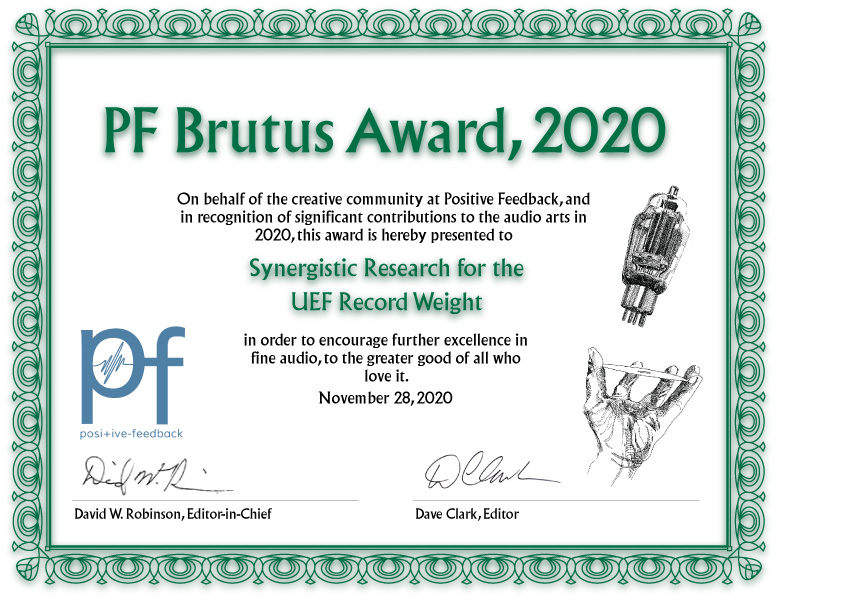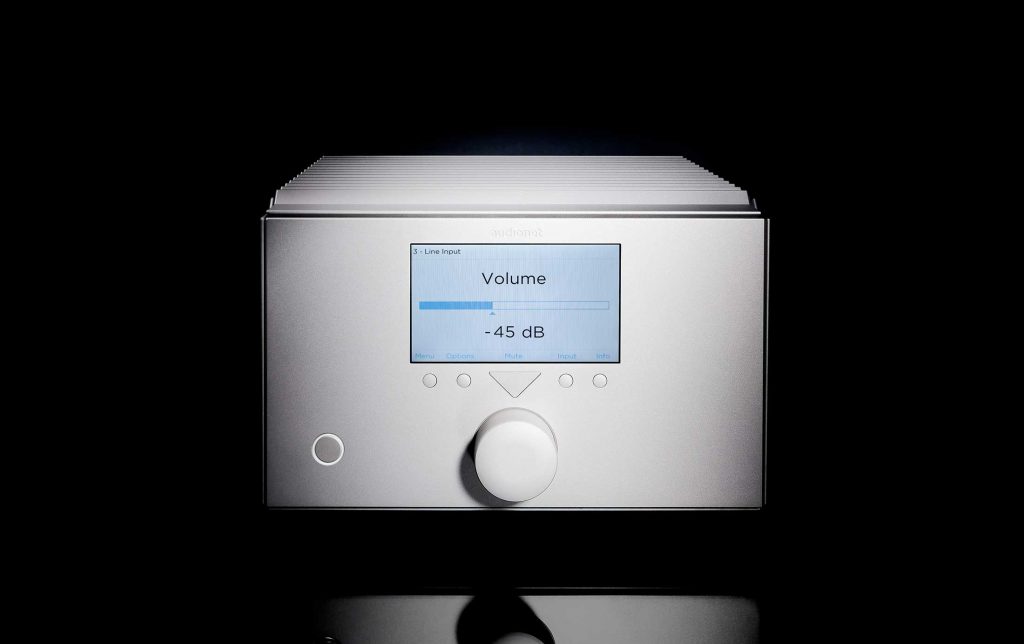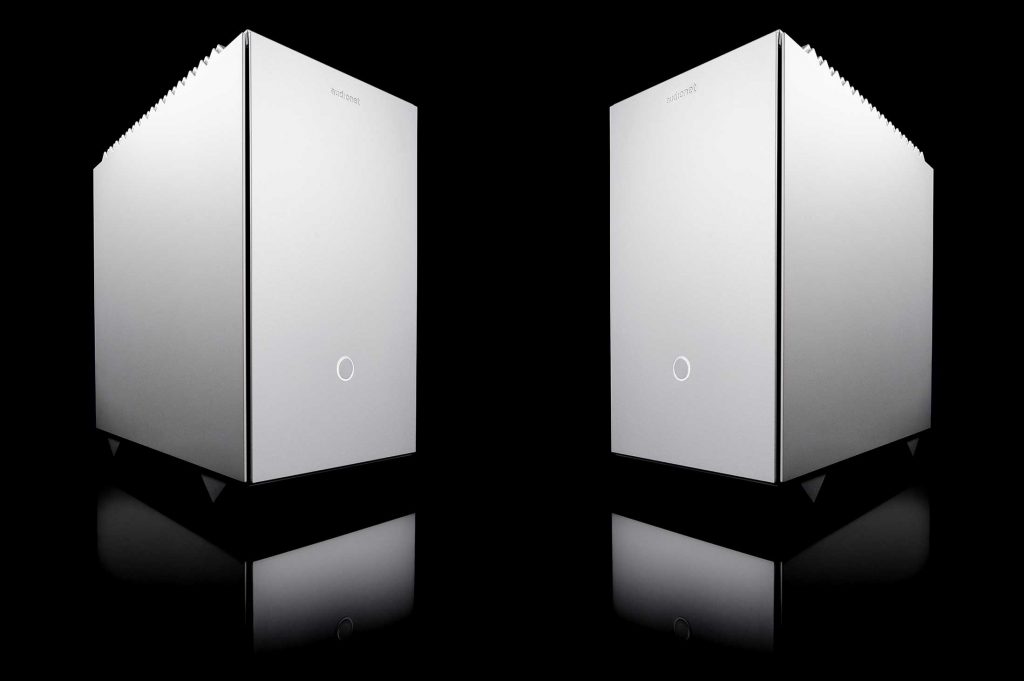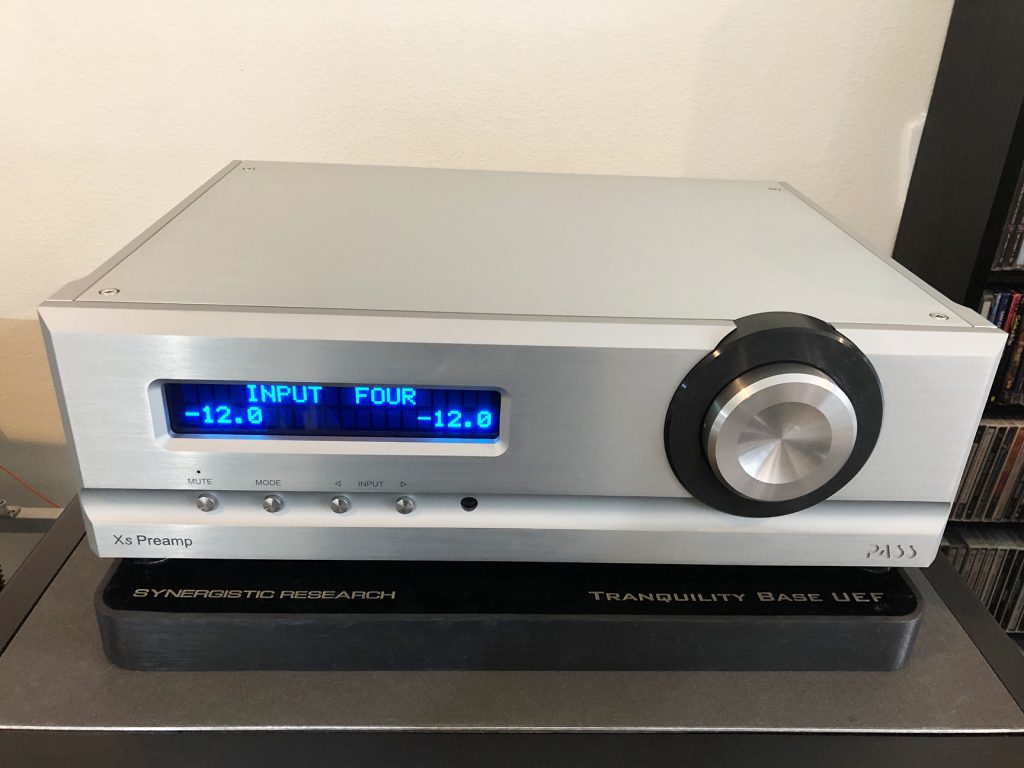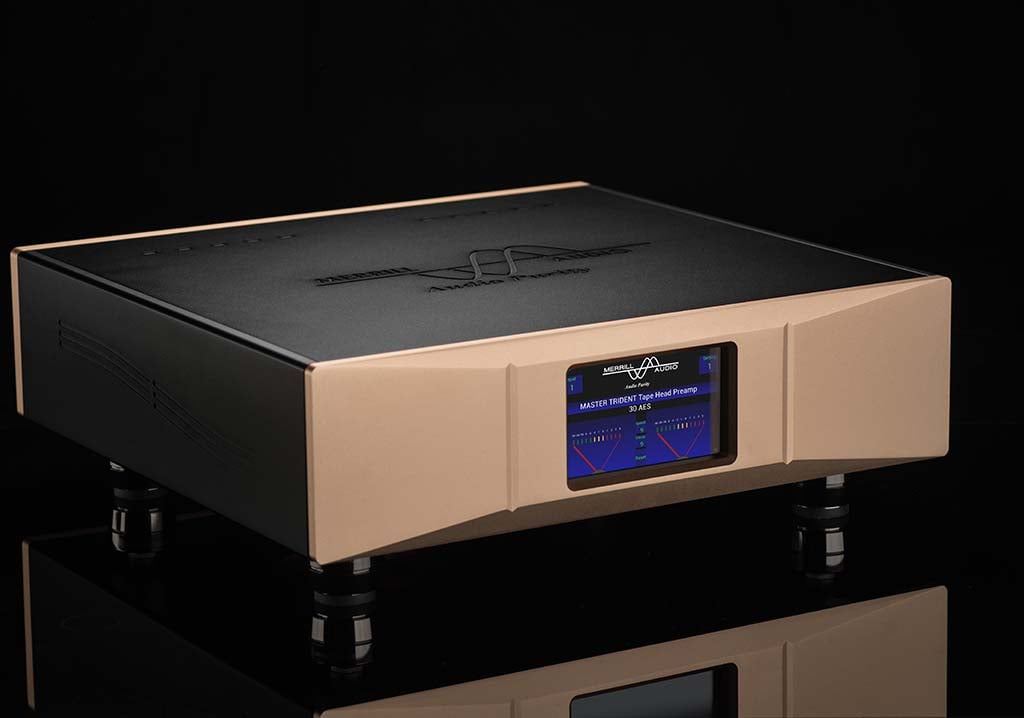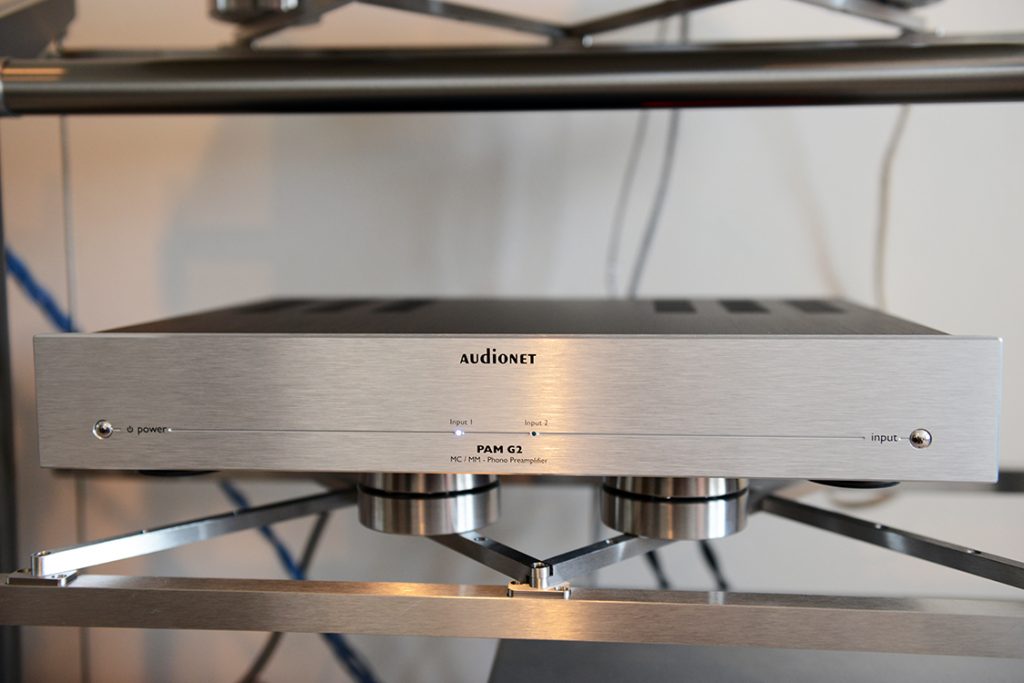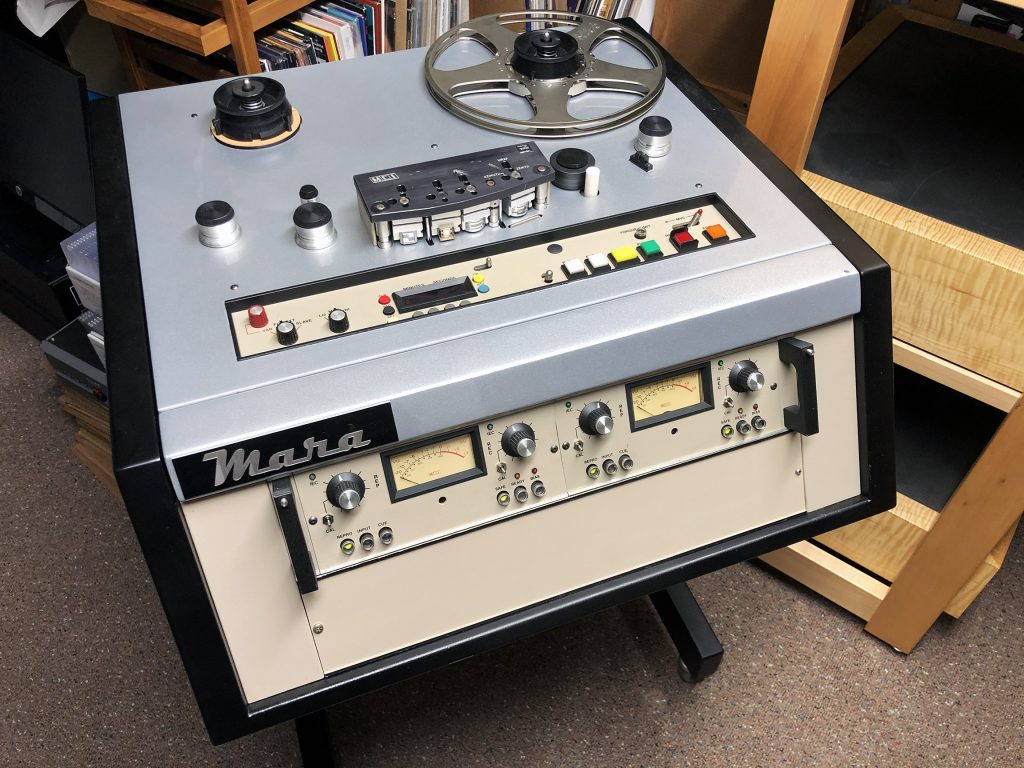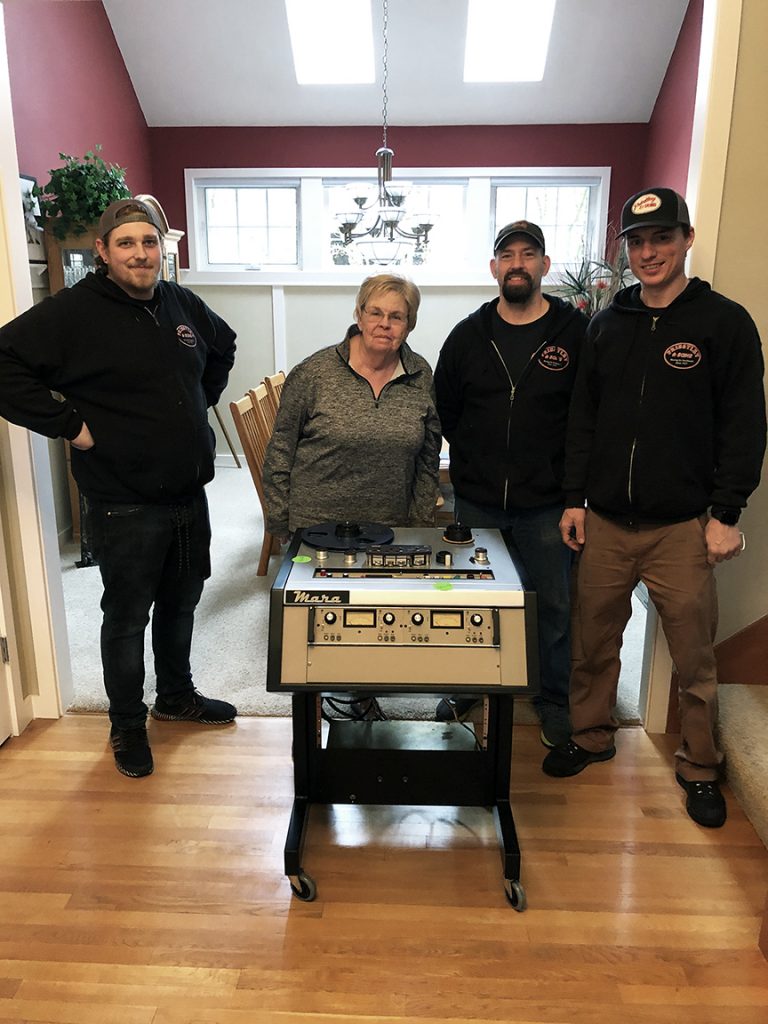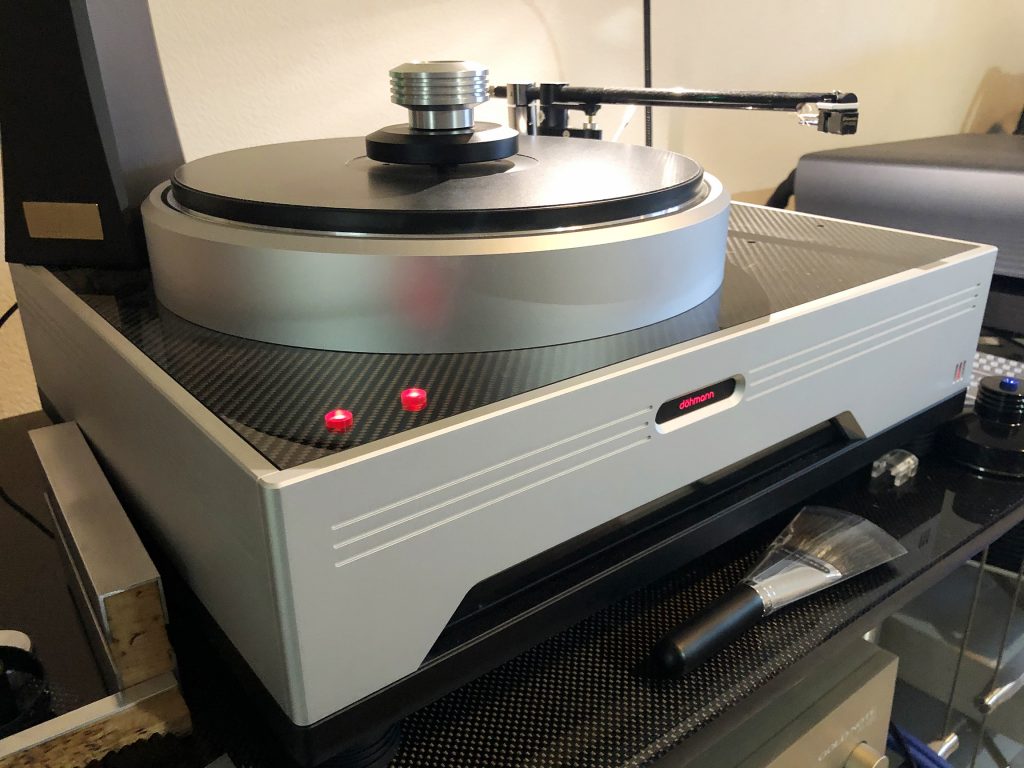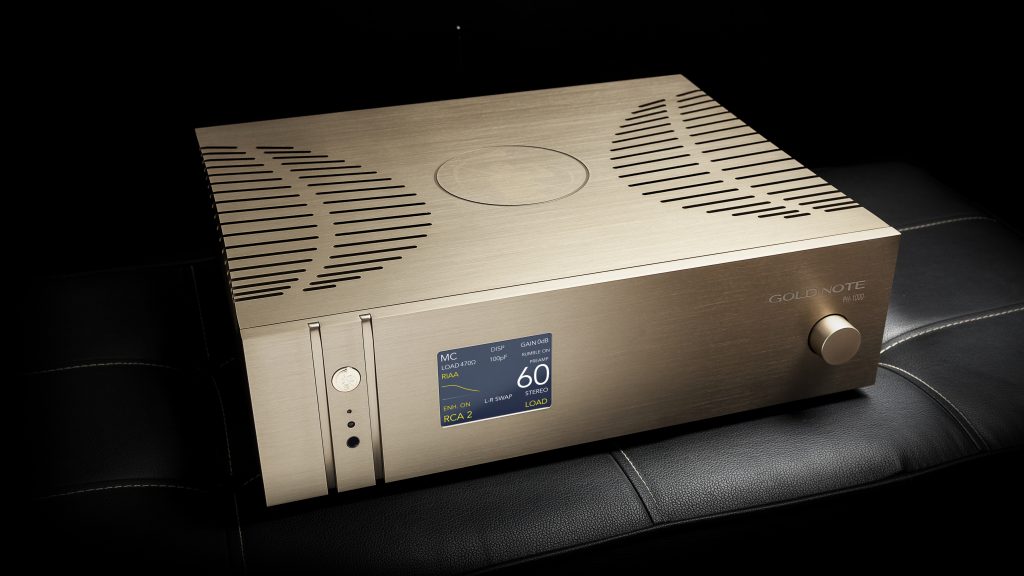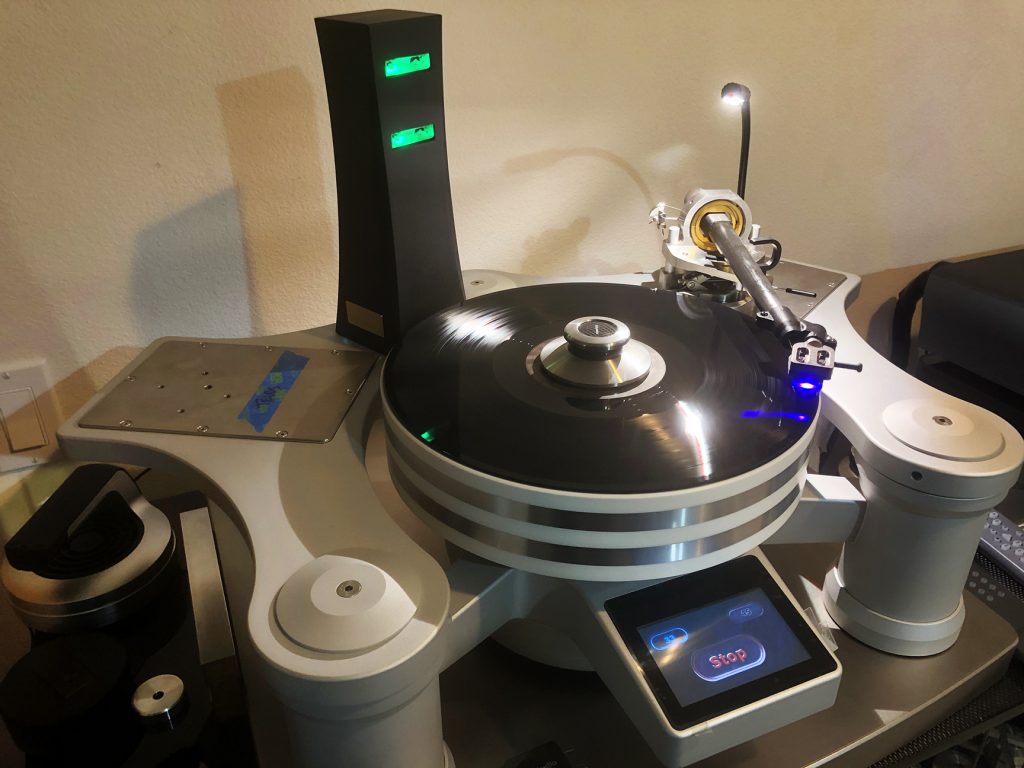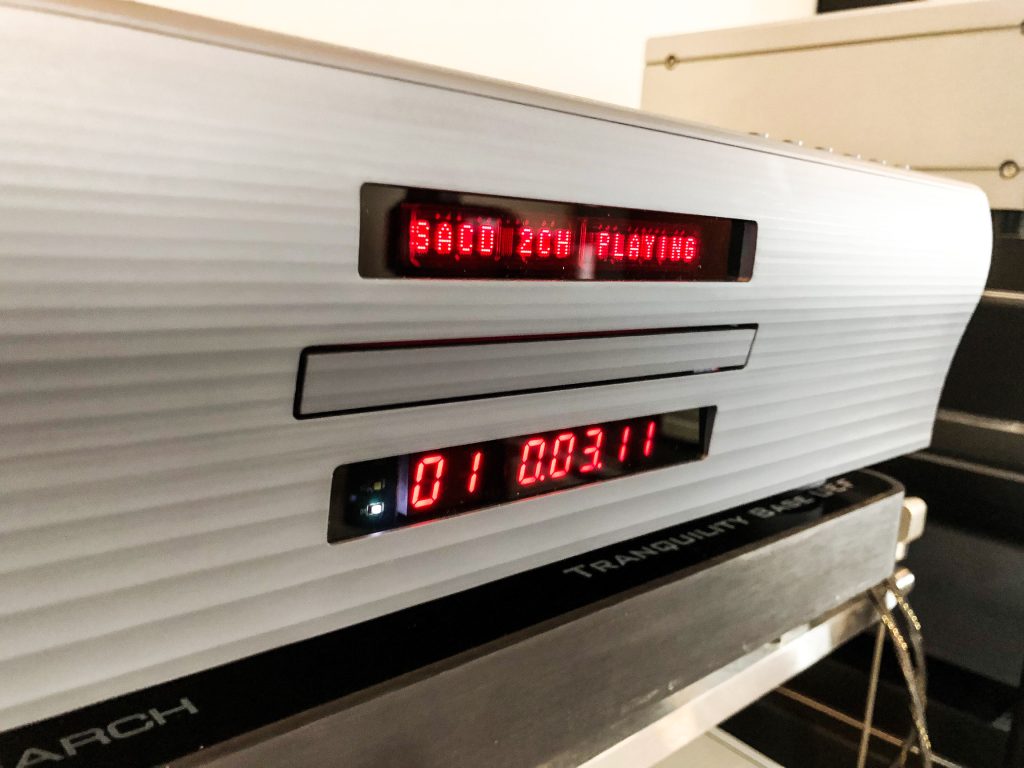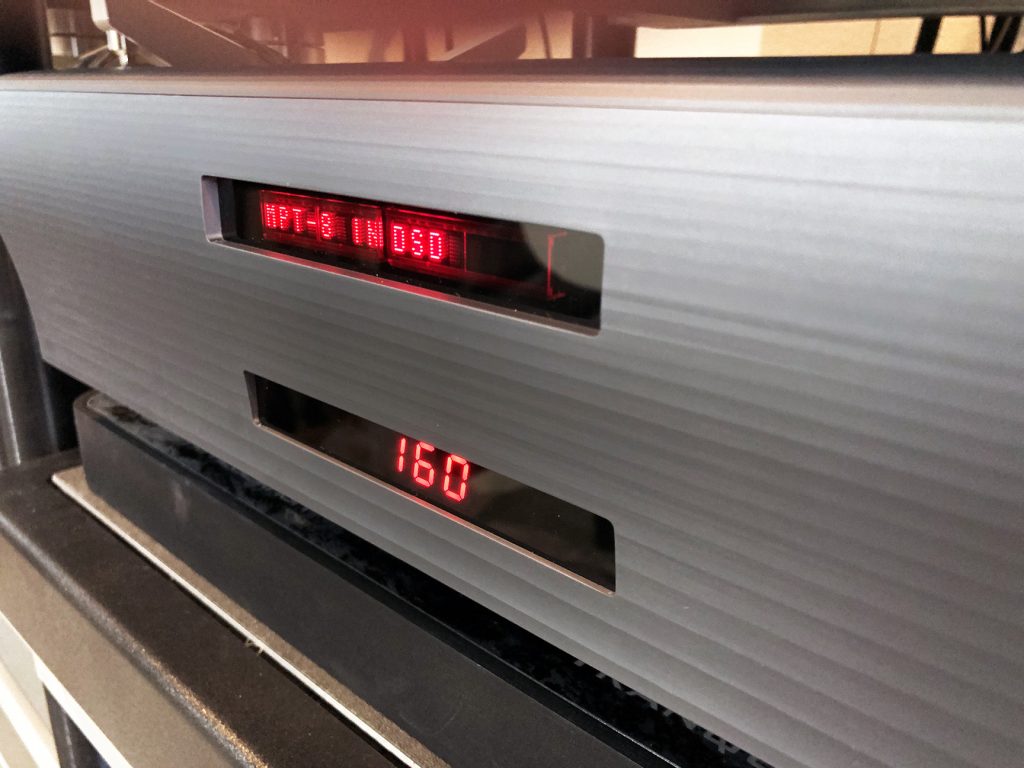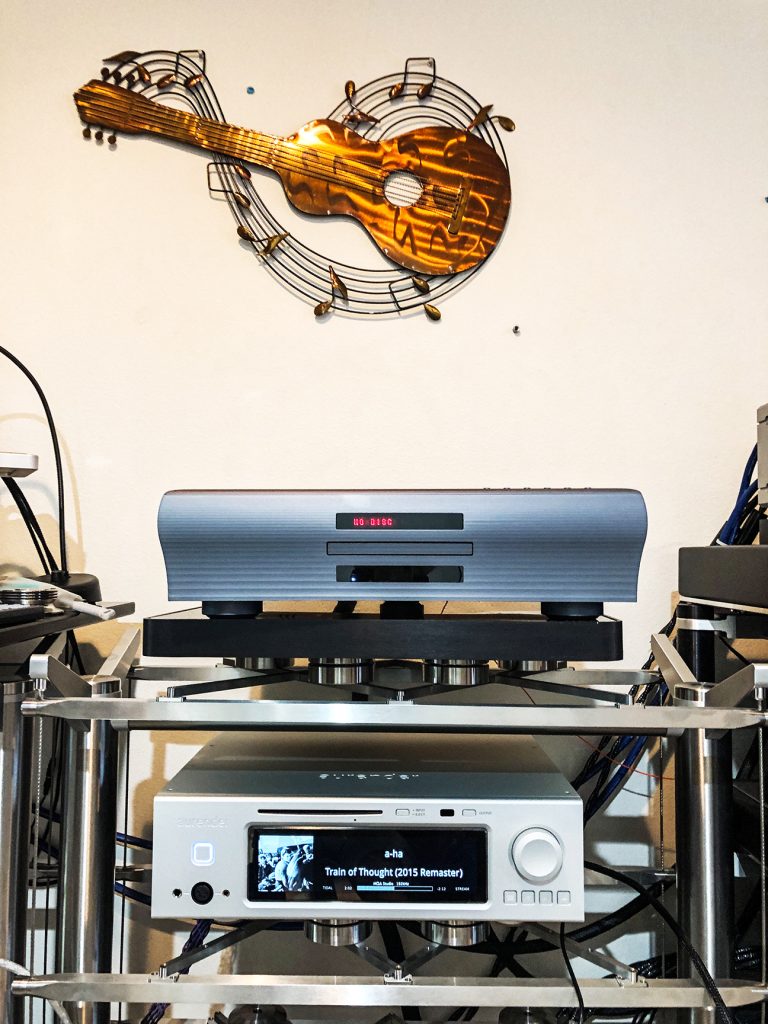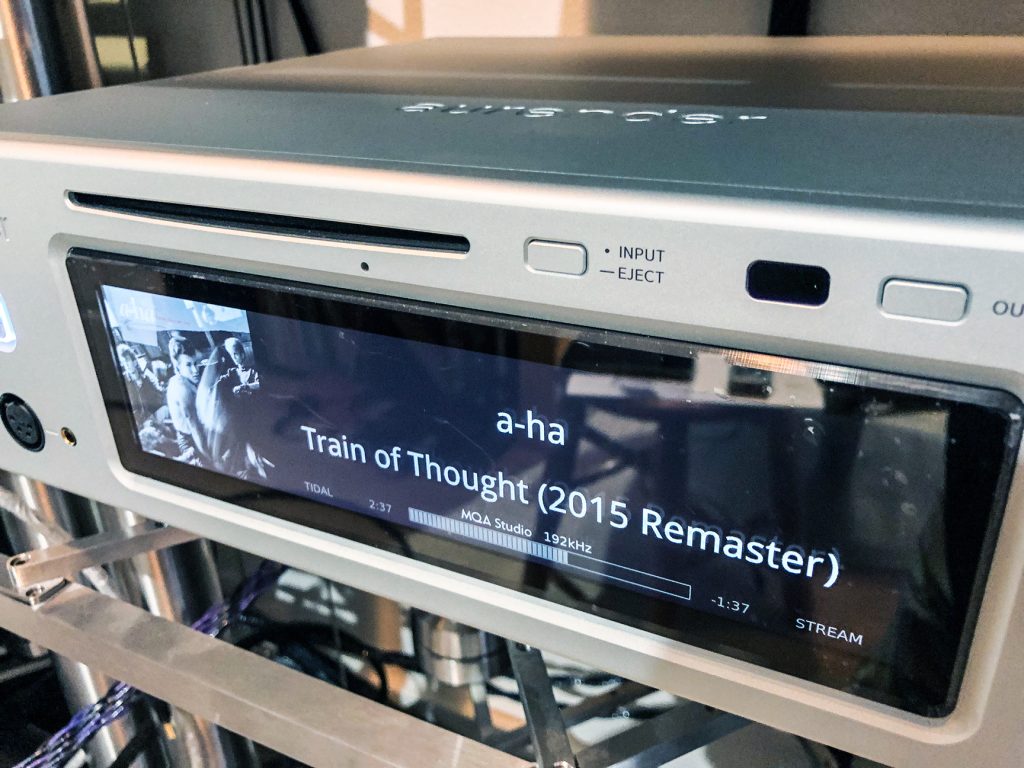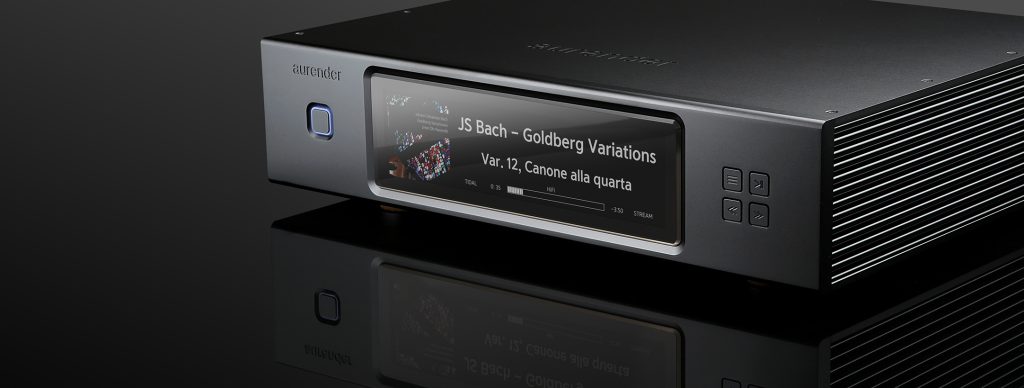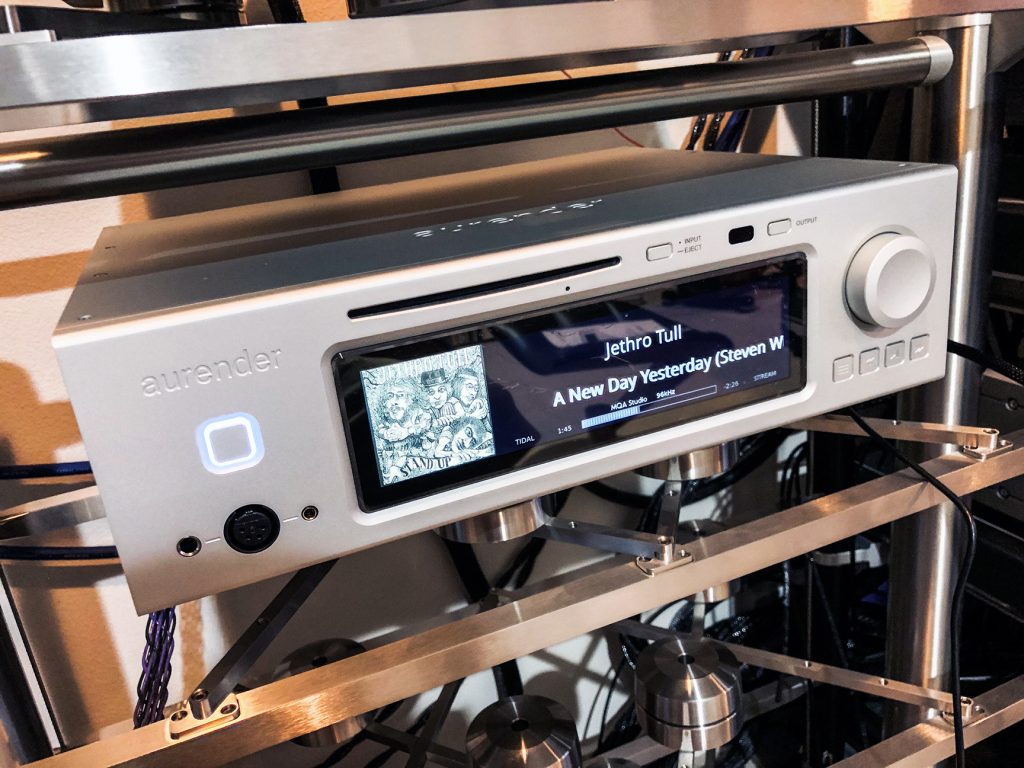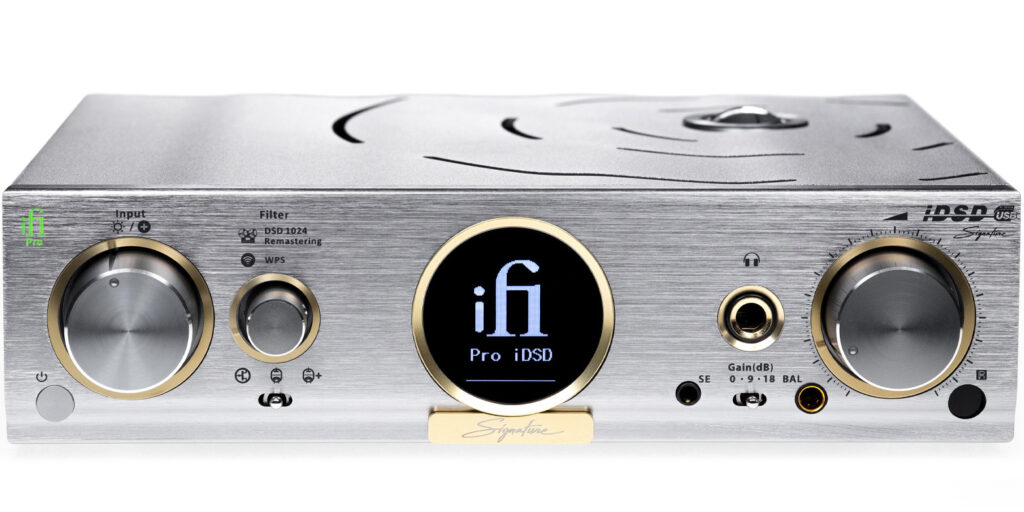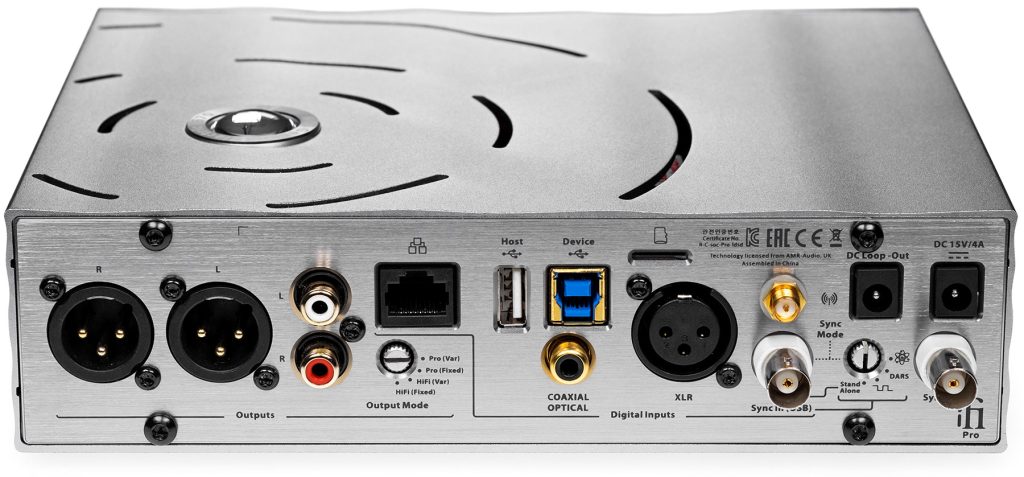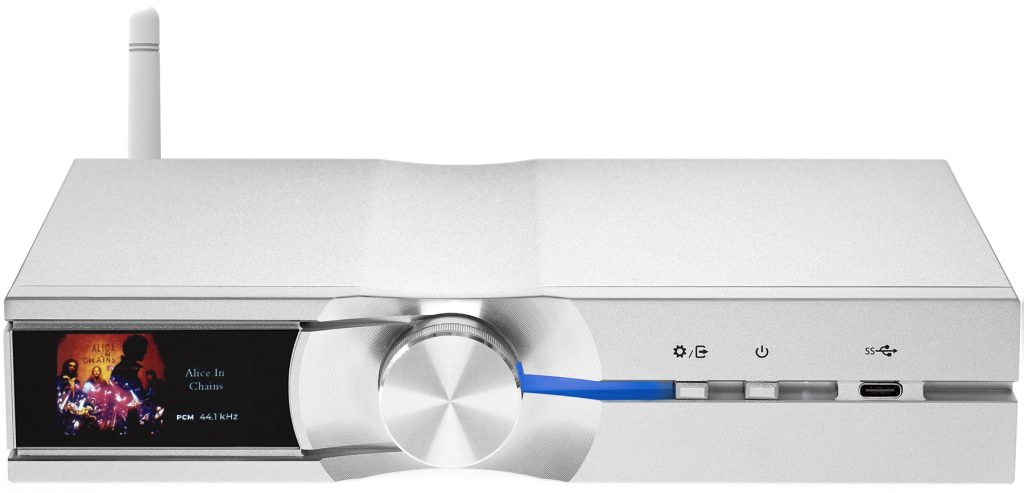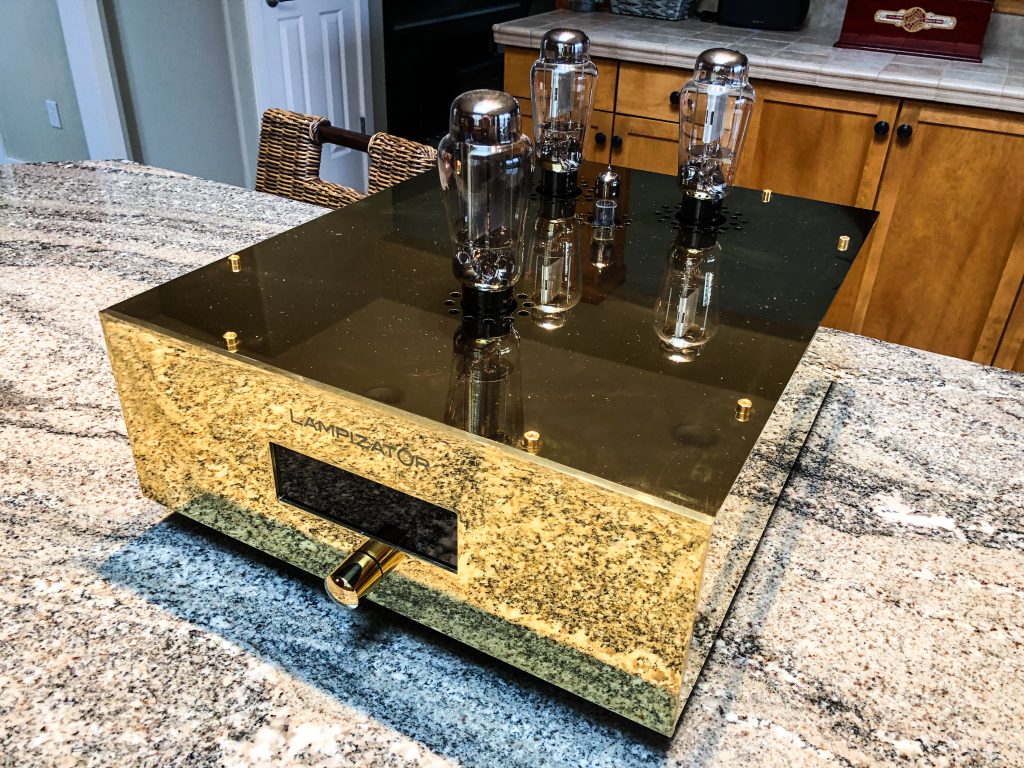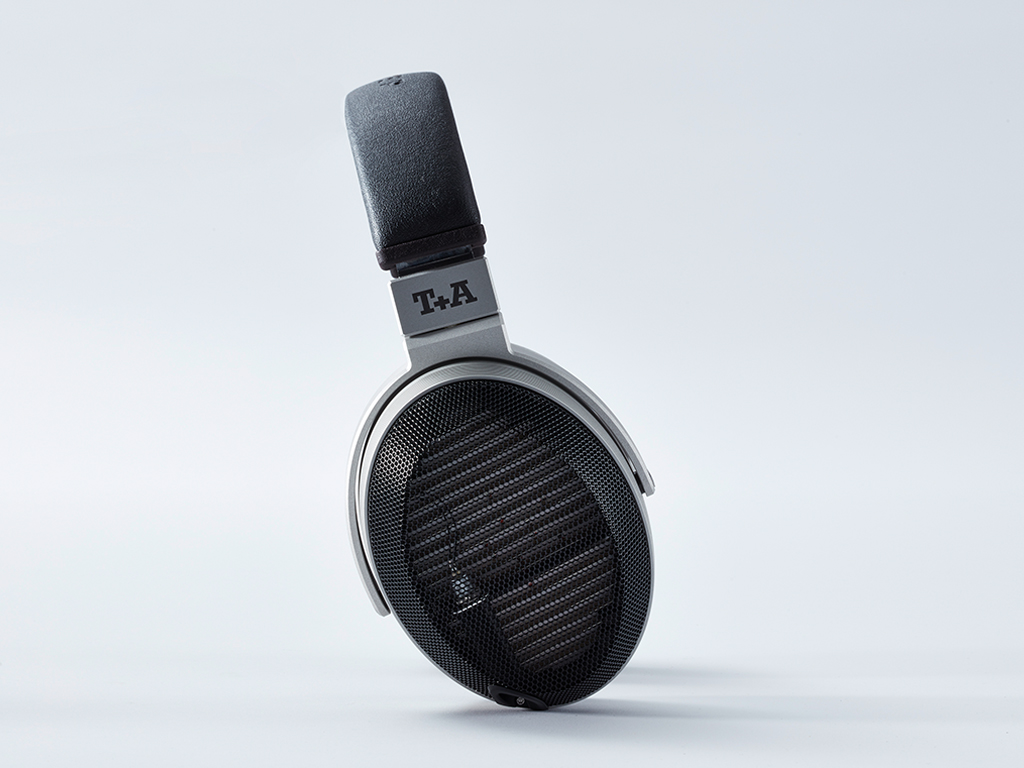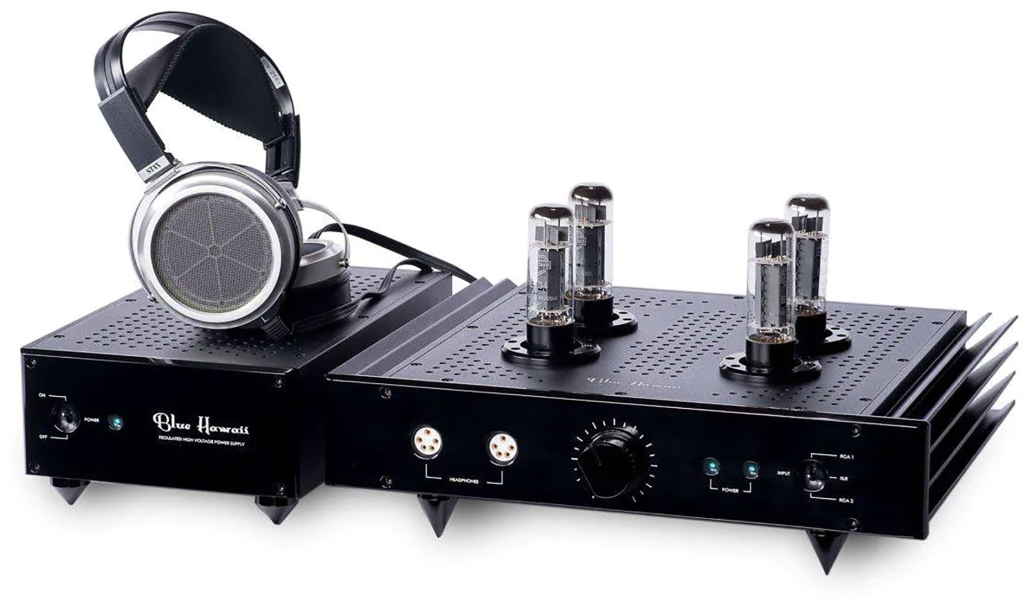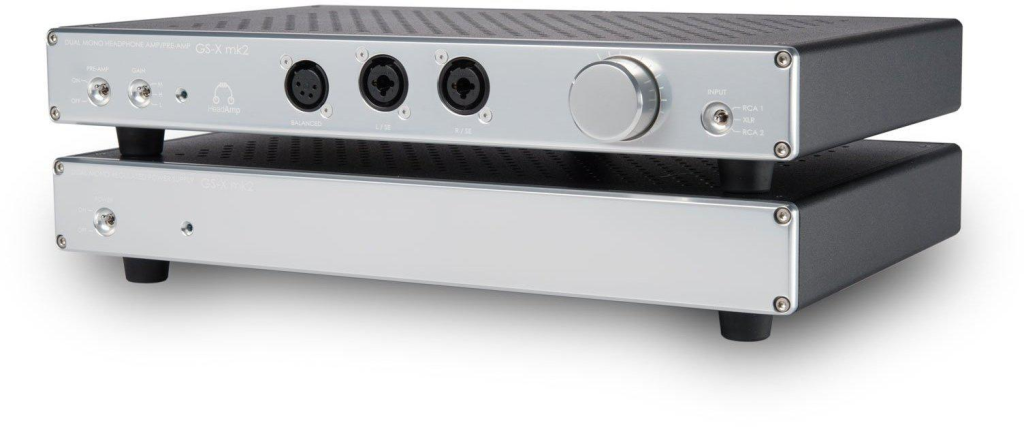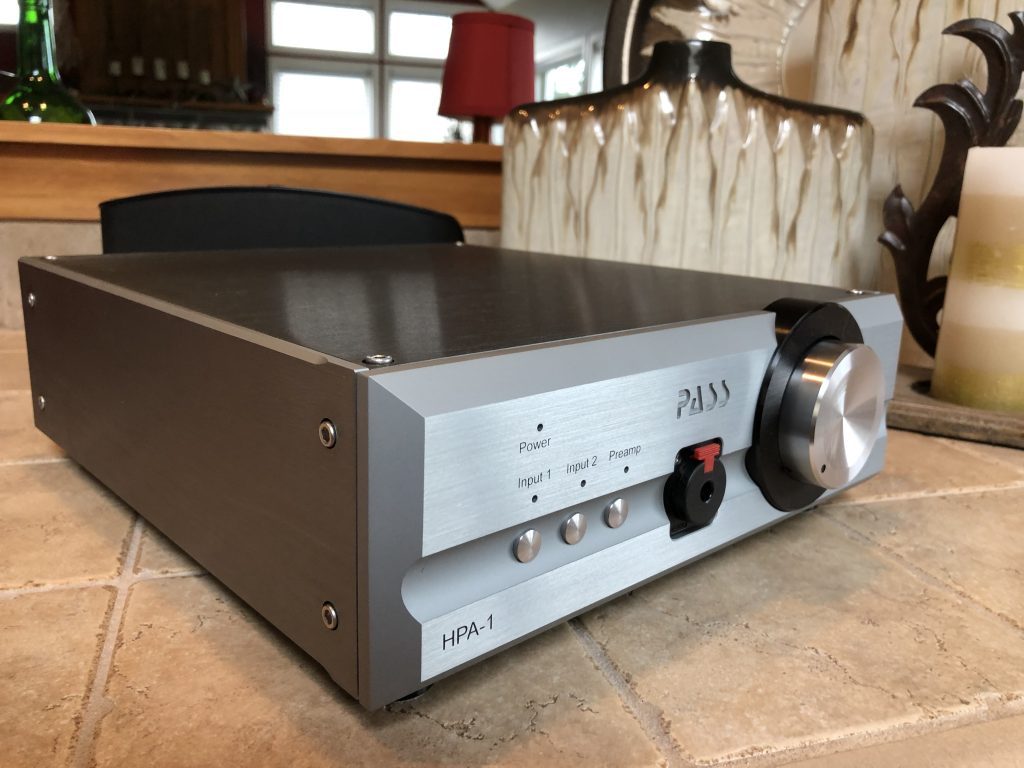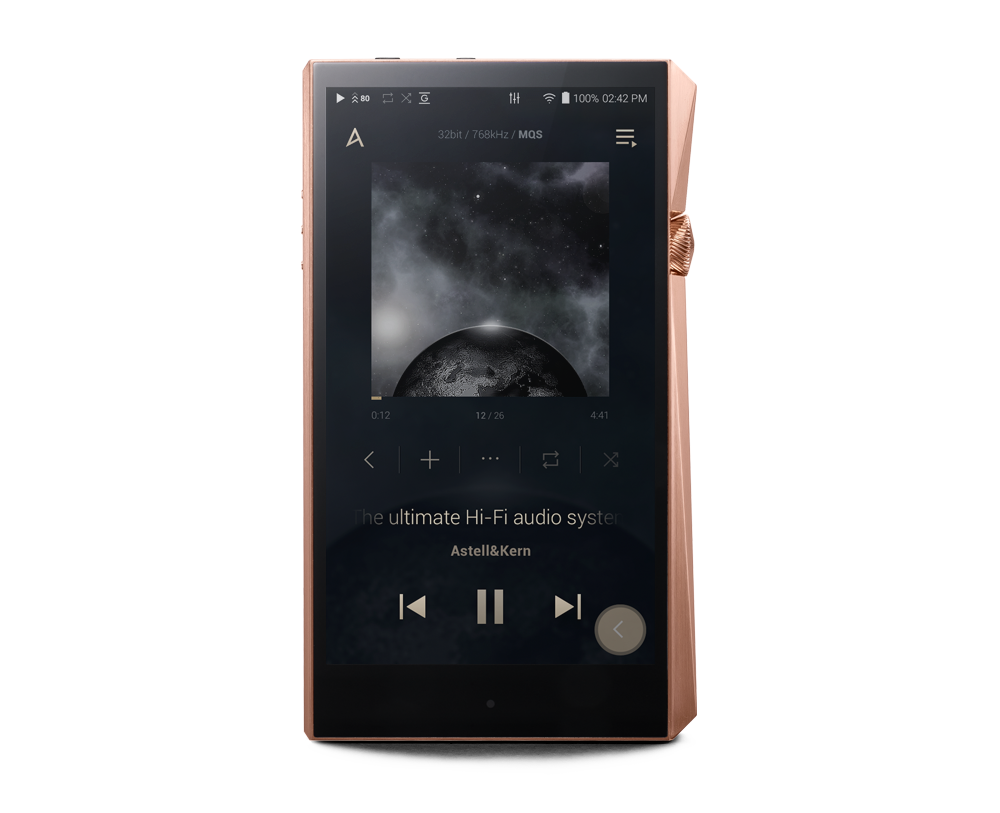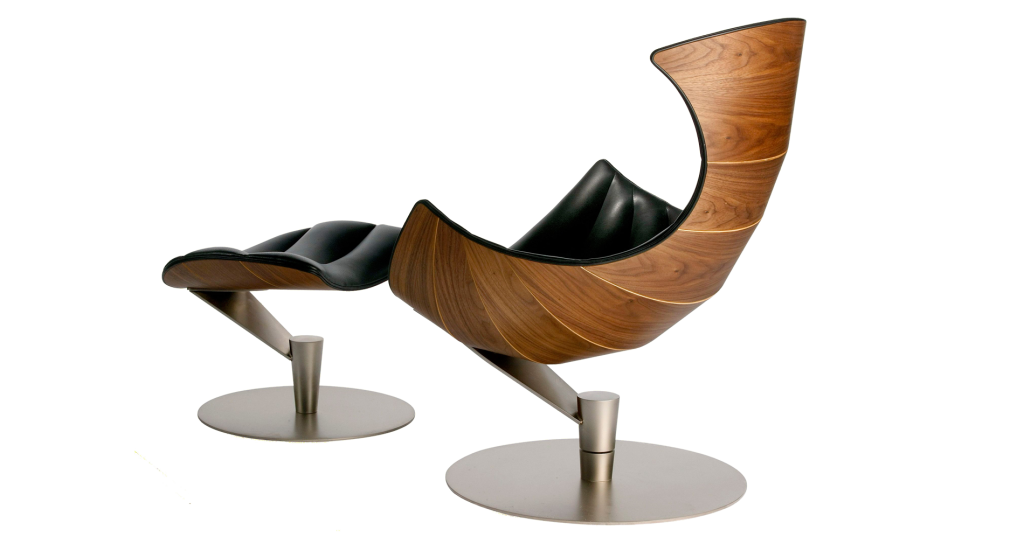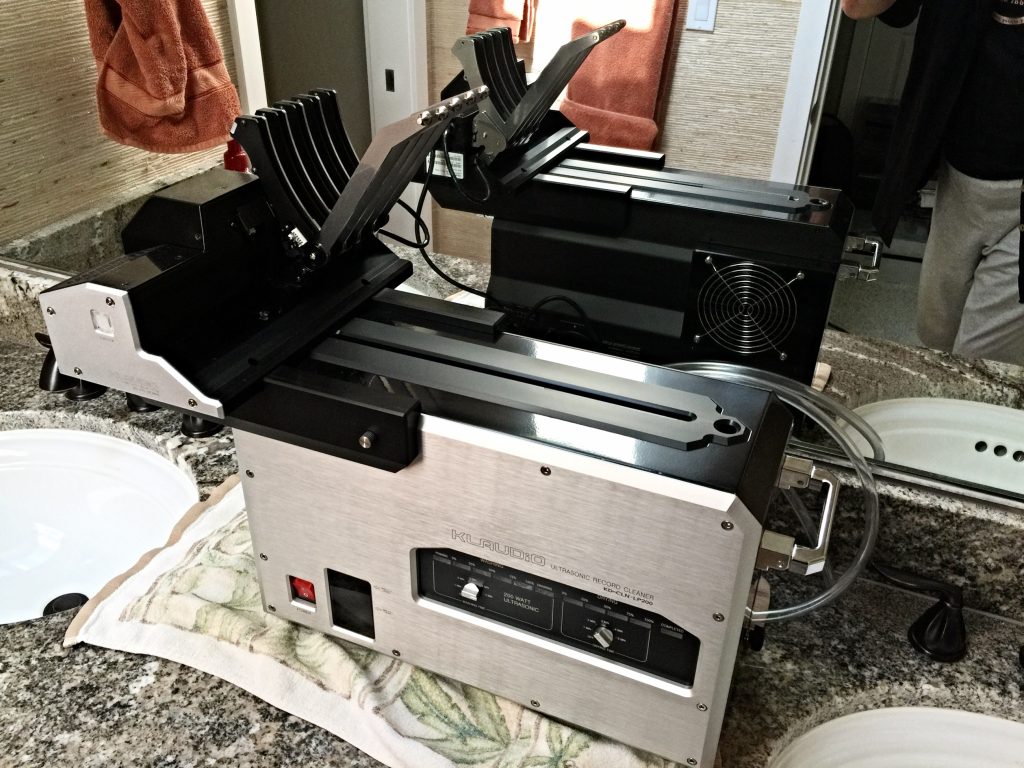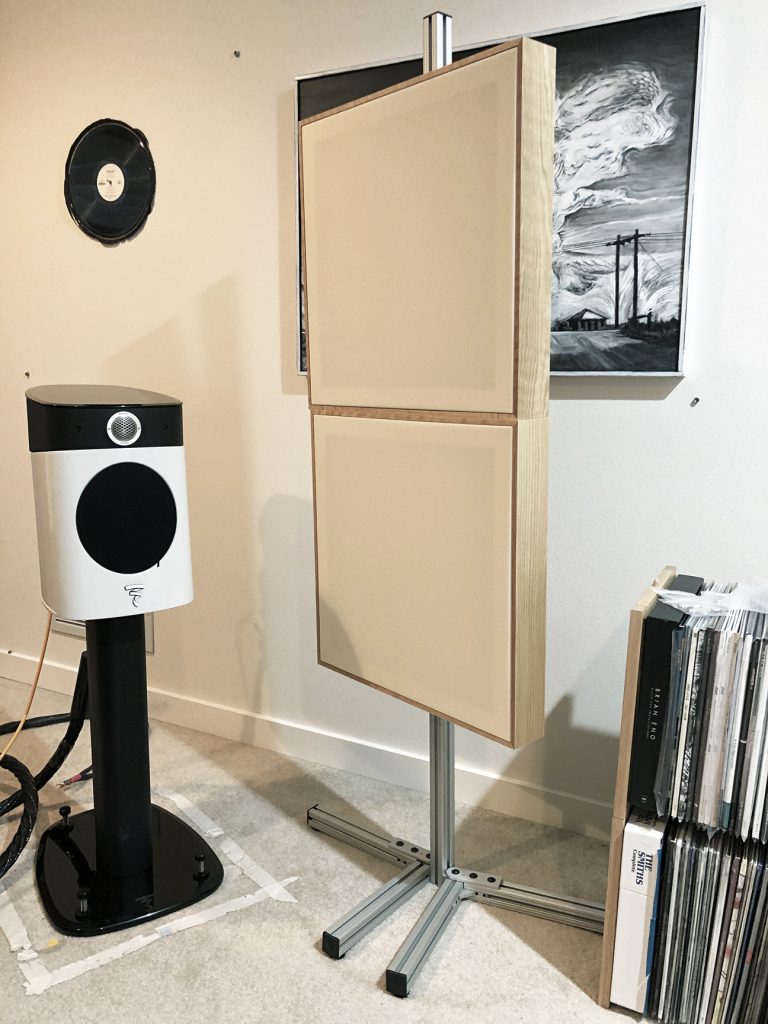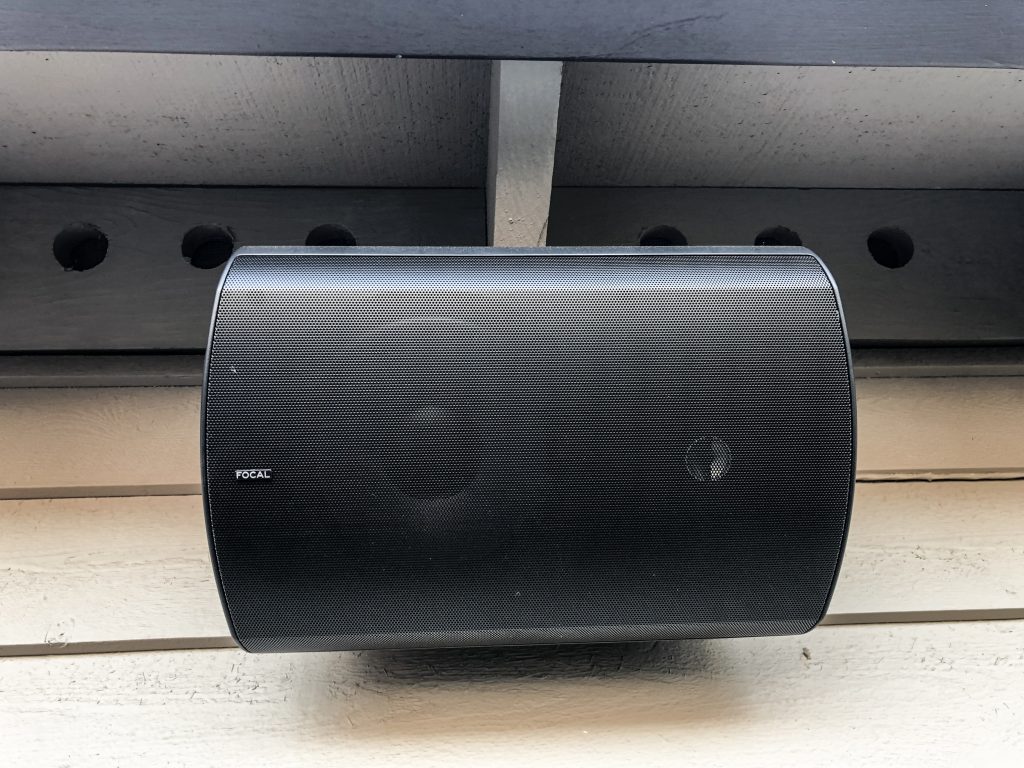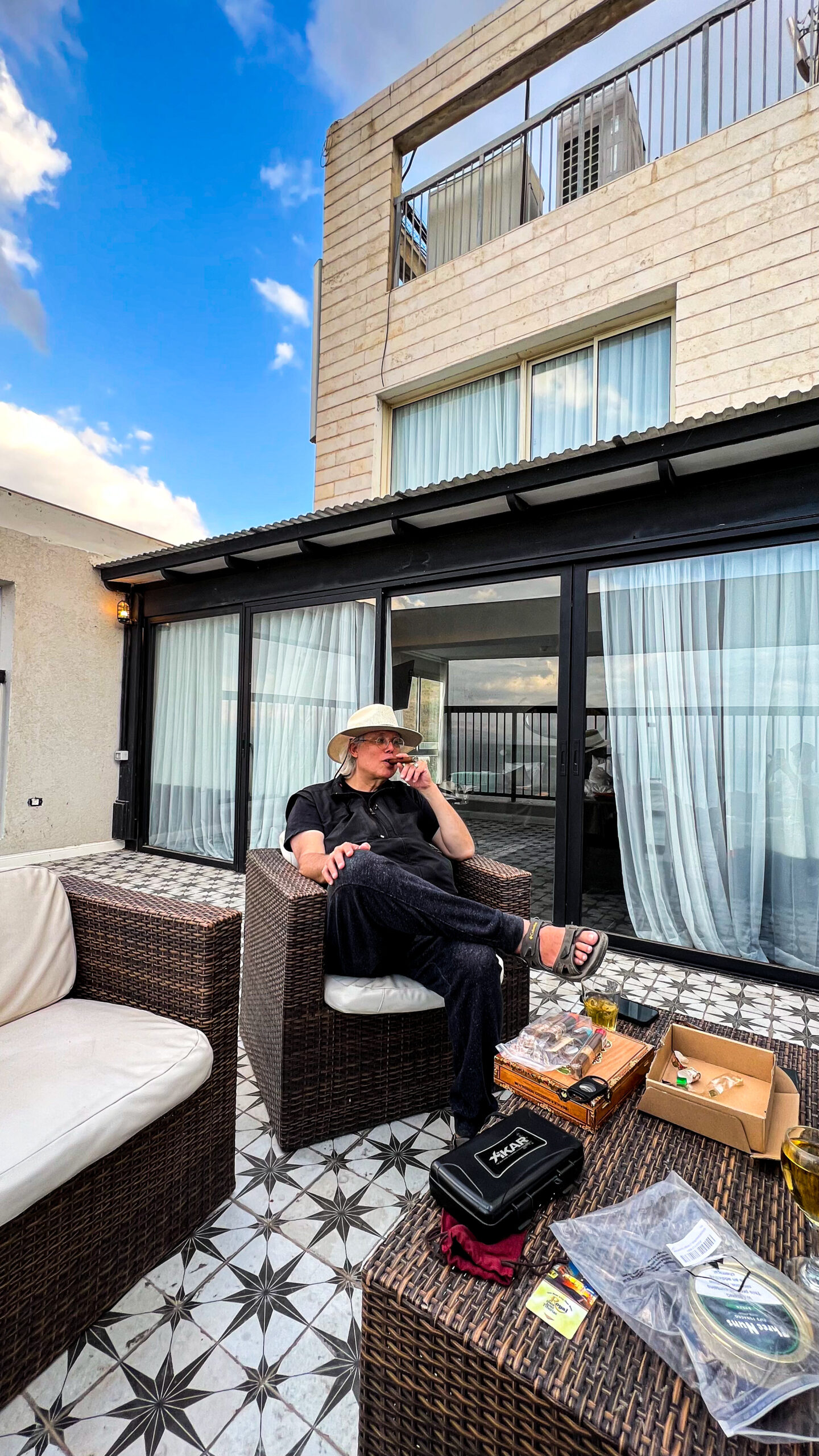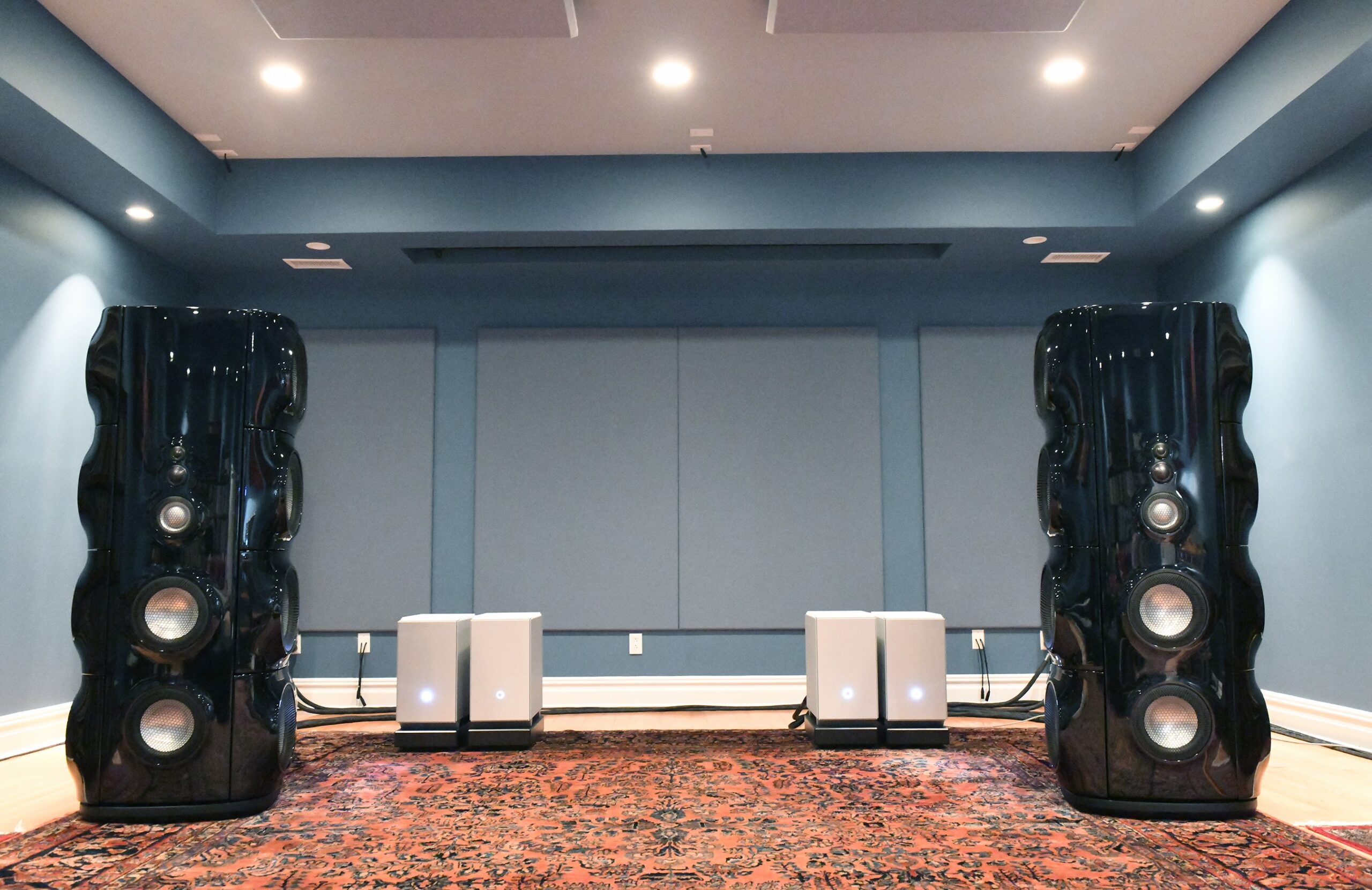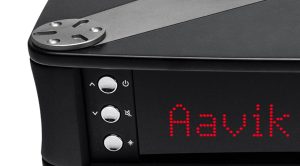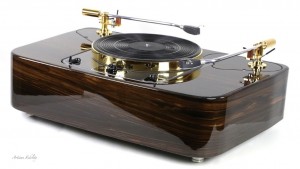
Yon Editor, contemplating... Photograph by John Robinson; image processing by David W. Robinson.
Here's the fourth installment of my Brutus Awards for 2020. Time flows...I goes.
Onwards....
The Mytek Brooklyn Bridge Streamer/DAC & the Mytek Brooklyn Amp+
Straight to this particular chase.
I have been listening to designs from Mytek Digital for many years now…all the way back to the Stereo 192 DSD. As Michal Jurewicz and company have advanced their designs, I have sampled and evaluated their work all along the way. Michal is a key audio artisan with a longtime commitment to DSD. The years have passed; Mytek's products have gotten better and better. Mytek has garnered a number of my Brutus Awards over the years, the latest being for their significantly improved Manhattan II DSD DAC in 2019.
This year two products from Mytek made my list for commendation.
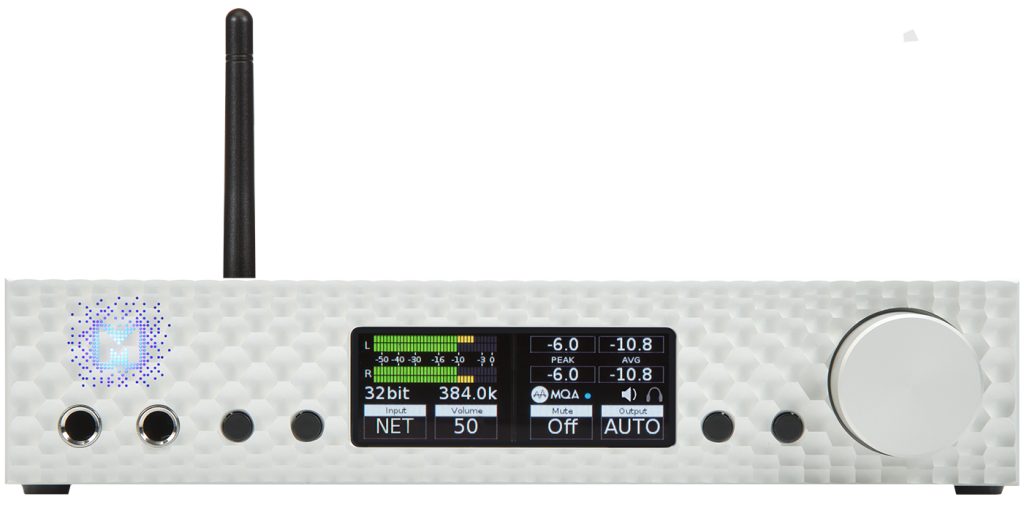
The Mytek Brooklyn Bridge. Image courtesy of Mytek Digital.
The first was the Brooklyn Bridge. This is Mytek's packaging of their very solid Brooklyn DAC+, the main difference being the addition of streaming and wireless connectivity to the mix. Mytek's summary of the feature set puts it all together (my comments in bracketed bold italics):
Specifications
- CONVERSION: up to 384k, 32-bit PCM, native DSD up to DSD256, DXD, 130dB Dynamic Range, ESS ES9028PRO chipset
- MQA HI-RES DECODER: built in certified hardware MQA™ decoder, full unfold to original sample rate [TIDAL users, take note. On the other hand, the Brooklyn Bridge is not Roon-ready. You'll have to provide a Roon-ready device if you want to directly control the Brooklyn Bridge with Roon.]
- NETWORK INPUTS: Ethernet CAT5 (PCM up to 24/192k, DSD64, WiFi (PCM up to 24/192k, DSD64) [Note that the network input limits both DSD and PCM inputs, something that audiophiles should be aware of.]
- DIGITAL INPUTS: USB2 Class2 (Windows ASIO Driver - all formats, Linux Drivers - all formats, Mac OS Driverless - up to 384 PCM, up to DSD 128 DoP), 2x S/PDIF (PCM up to 24/384k, up to DSD128 DOP), Toslink (up to 24/176k, DSD64 DoP) [As usual, the USB input gives you Native DSD out to DSD256, and will be the preferred input for highest performance. The 2x S/PDIF is a handy upgrade. Mac users are limited to DSD128.]
- CLOCK: "Mytek Femtoclock Generator™" 0.82ps internal jitter.
- ANALOG OUTPUTS: RCA, balanced XLR, simultaneous, 75 Ohm impedance
- HEADPHONE OUTPUTS: Reference High Current, High transient Headphone Amp, 500mA, 6 Watts, dual headphone jacks, designed to drive hard to drive headphones. [Having a pair of ¼" headphone jacks is a very handy feature. Note the 6-watt power rating.]
- BUILT-IN ATTENUATOR: Choice of 1dB step analog attenuator, separate for main out and head-phones, 1dB step digital 32-bit attenuator and purist relay bypass.
- BUILT-IN ANALOG PREAMP: Line level input or Phono M/M, M/C input, relay controlled. [Note that this is RCA input only.]
- AUDIO INTERFACE FUNCTION: All digital inputs can be routed into computer via USB2. Allows connection of external digital sources such as CD Players and digitizing ADCs. [This also allows you to stream Qobuz/TIDAL via computer-based apps, outputting the audio stream to the Brooklyn Bridge via USB 2.0.]
- REMOTE: Included, universal remote capable [This is a standard Apple Remote.]
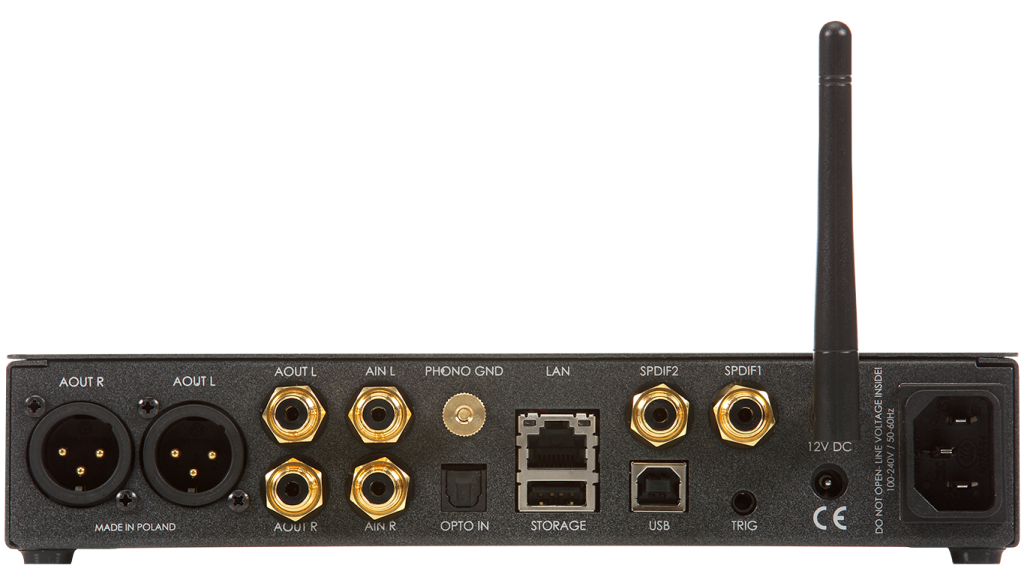
Rear view of the Mytek Brooklyn Bridge, showing its array of I/O ports (image courtesy of Mytek Digital)
I used our Dell XPS 13 i7 notebook computer via USB to act as a music server to the Brooklyn Bridge. The Mytek ASIO USB drivers were loaded on this Windows 10 machine. LAN-based music was delivered by JRiver's Media Center 25 (now in version 27). The sonics reflect the later generation of Mytek sound. It's still strong on dynamics…Mytek's obvious signature with its DACs since the Stereo 192 DSD…but the punchiness of earlier iterations has become more refined, with improved harmonic integration. The noise floor is commendably low, and the sense of quiet control is solid.
At its retail price point of $2995, the Mytek provides a great deal of functionality in a single compact package. There are some limitations, as noted in my comments on the specifications…particularly the lack of Roon-Ready capability…but for those who can supply Roon via computer/streaming via computer-based apps, the Mytek Brooklyn Bridge is certainly an option. For TIDAL users, the presence of MQA is a key consideration. And the provision of dual headphone jacks also allows the Brooklyn Bridge to be used by couples for the sharing of high-resolution music without compromise.
There's enough here to merit one of my 2020 Brutus Awards.
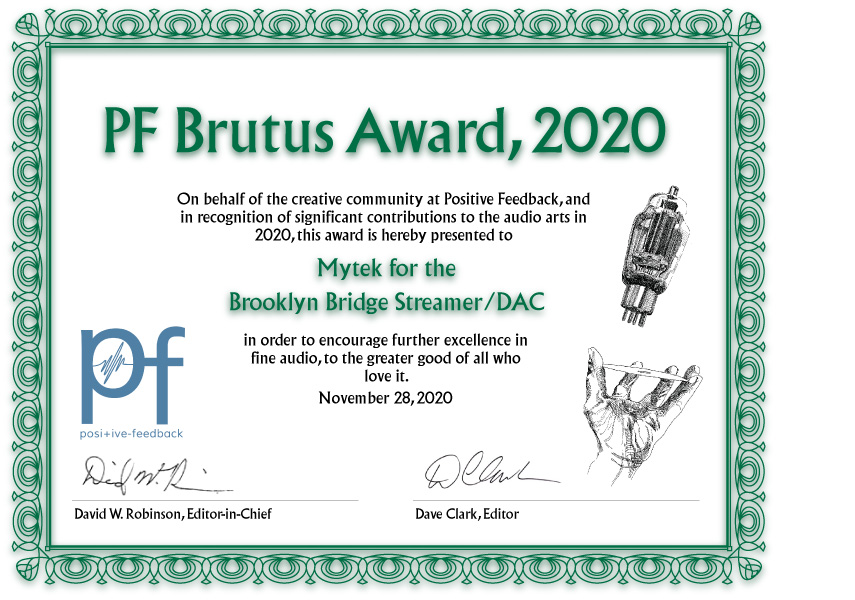
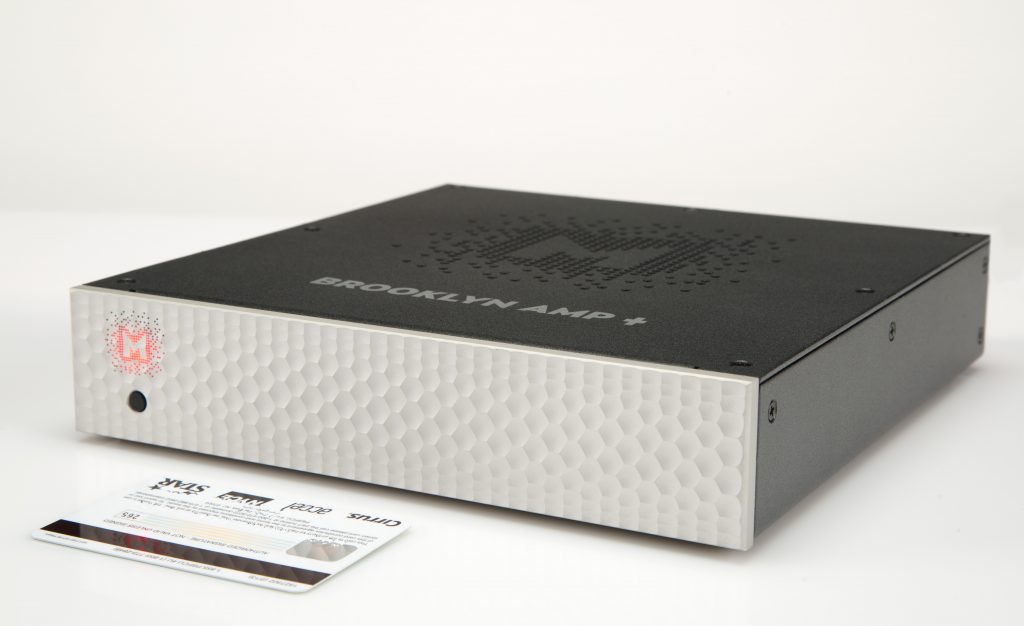
The other Mytek product that I'll recognize this year is the surprisingly compact Brooklyn Amp+. This is an updated design of their earlier Brooklyn Amp, which has impressed me before with its combination of compact size and significant power.
Specifications
- POWER RATINGS AT 1% THD: at 16 Ohm - dual mono 2 x 130 W. at 8 Ohm - dual mono 2 x 250 W, at 4 Ohm - dual mono 2 x 300 W, at 2 Ohm - dual mono 2 x 400 W, Peak - dual mono 2 x 1200 W
- OUTPUT SWING: 70 Vp / 140 Vpp (unloaded)
- SNR: >121 dB
- FREQUENCY RESPONSE -3dB: 10Hz - 30kHz
- THD REGULAR USE: <0.01%
- PROTECTION CIRCUITRY: Short circuit protection, DC protection, under voltage protection, temperature protection, overload protection
- DAMPING FACTOR: >400
- DC POWER ON TRIGGER: 12VDC minijack
- WORLDWIDE POWER SUPPLY: 100-240VAC 50/60 Hz
- DIMENSIONS: WxDxH=8.5x9.5x1.74" = 216x241x44mm
- WEIGHT: 6lbs, 3kg
- WARRANTY: 2 years
According to Mytek, the Amp+ took the virtues of the earlier Amp, and spiced them up. Their Web site says:
"[The] Brooklyn AMP+ retains the same type of sound with dynamic and precise transients and even and extended frequency response, but with way less low-level distortion and cleaner natural, analog-like character, with deeper, larger soundstage.
Brooklyn AMP + features new faster transistors, cutting the so called ‘switching dead time' to low nanoseconds, and [a] faster and higher 650kHz carrier clock. They both contribute to greatly improved low-level detail and lower distortion. In addition, the output filter frequency has been increased two-fold for lighter highs and to better accommodate difficult loads."
Overall, I'd agree with Mytek's comments here. They match my extended listening impressions over many months in our outdoor listening system here. In fact, I was surprised by the obvious sonic advance the Amp+ had over the earlier Brooklyn Amp.

Michal sent me a final pre-production version of the Amp+ to evaluate. I used it in our reference outdoor system (Furutech 303 Daytona AC Conditioning/Power Distribution, exaSound PlayPoint Music Server, exaSound e32 and e62 DACs, Roon over the top of Qobuz and TIDAL, Mytek Brooklyn Amp+, Focal 100 OD8 Outdoor Loudspeakers) over a period of about 4-5 months.
The Amp+ is noticeably more detailed and quicker than before, but more than that, it's more musical than the earlier Amp. I heard it immediately, and liked it very much. For such a compact package to make sure a real step forward is worth noting. Those of you looking for a powerful, small, energy-efficient stereo amplifier that does an excellent job of delivering the sonic goods: here ‘tis!
A mighty mite of an amp, and a 2020 Brutus Award winner, for sure.
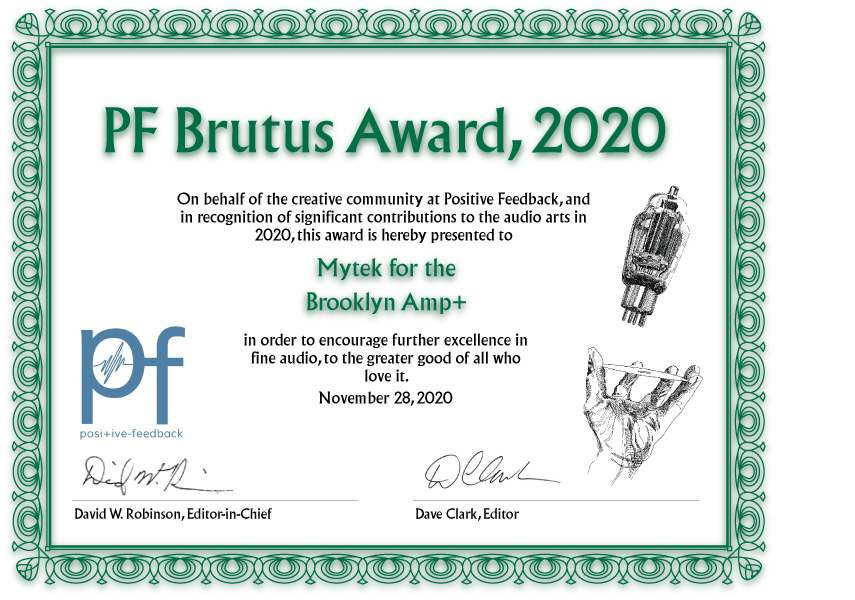
Synergistic Research PowerCell SX
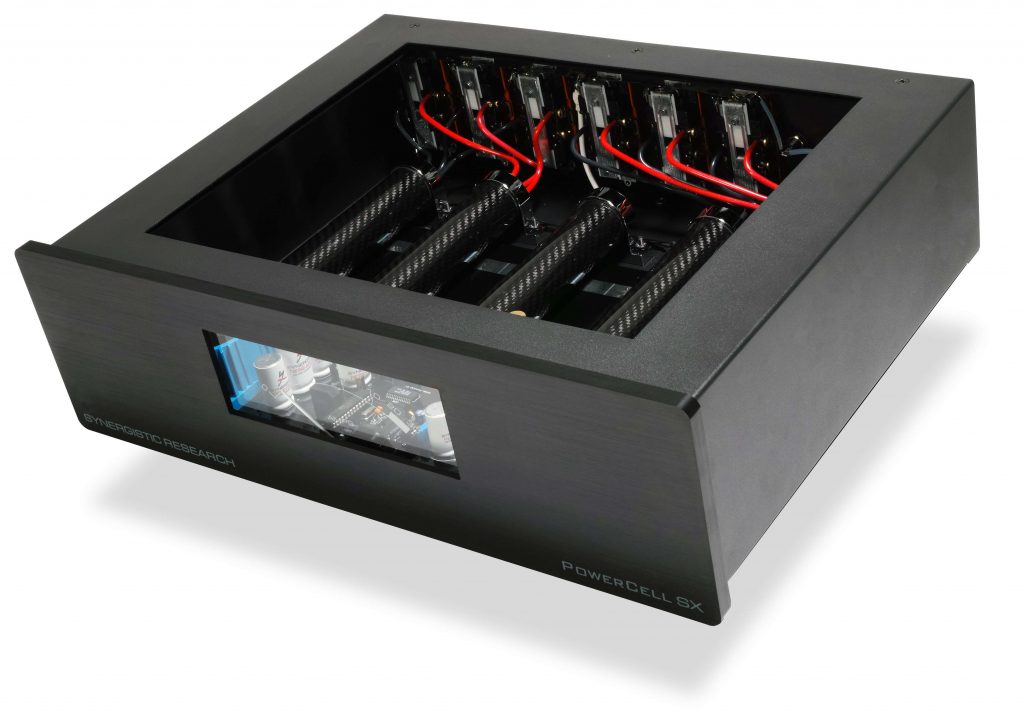
Images courtesy of Synergistic Research
Ted Denney and Synergistic Research have been doing pretty bloody amazing work in high-end audio for many years now. Search PF; you'll find a number of reviews, commentaries, reviews, and awards that we've given SR over the years. No surprise, since the quality of his work is so outstanding, and I've known the Denneymeister since 1994 or so, when he dropped by my place du jour to meet me and talk audio. Good times.

Ted Denney digging the LPs at Music Millennium in Portland, OR, 2019 (photograph and image processing by David W. Robinson)
Ted Denney and SR delivered their new PowerCell SX early in 2020. I had been using the SR PowerCell 12 UEF for several years before this, and had always been highly pleased with the improvement that it had brought to our reference stereo listening room.
The new SX revision of the PowerCell borrows much of the technology of the now-vanished-because-sold-out Galileo SX Reference Power Conditioner. As Synergistic Research notes on their Web site:
"Technological innovation starts with the Galileo SX PowerCell's more densely rolled Active Electromagnetic Cells for enhanced filtration and a lower noise floor. PowerCell SX then gets the Galileo SX's power supply and Schumann Resonance Generator to power and bias its six internal EM Cells. And just like the Galileo SX PowerCell that biased all Active EM Cells, PowerCell SX's Schumann Resonance generator biases its six Active EM cells, both rolled and flat. In contrast, the standard PowerCell 12 only biases the single flat EM Cell and with a less powerful field generator. Other improvements include the same ground filtration topology as found on the Galileo SX PowerCell for lower noise and a more holographic soundstage, and a unique ability to ground PowerCell SX to a Synergistic Research Active Ground Block for even higher performance without sacrificing any of your twelve AC outlets. And new to PowerCell SX are Orange Capacitors with Orange Fuse technology used in the power supply and field generator offering benefits over both the Galileo SX PowerCell and PowerCell 12. There's even an Amp Meter that allows you to view the beautiful hand-built circuit as you monitor your system's energy consumption."
Our setup used the SR Active Ground Block, SR SX power cabling. Our room itself has already been treated with a complete set of HFTs, Tranquility Pods, SR fuses in select components, and features the SR Atmosphere Infinity, all Brutus Award winners in 2019 or before. The cumulative beneficial effect of this array of SR gear has been foundational in the developing the extraordinary audio performance in our reference stereo listening room, particularly, but also in our multichannel room, and our office system.
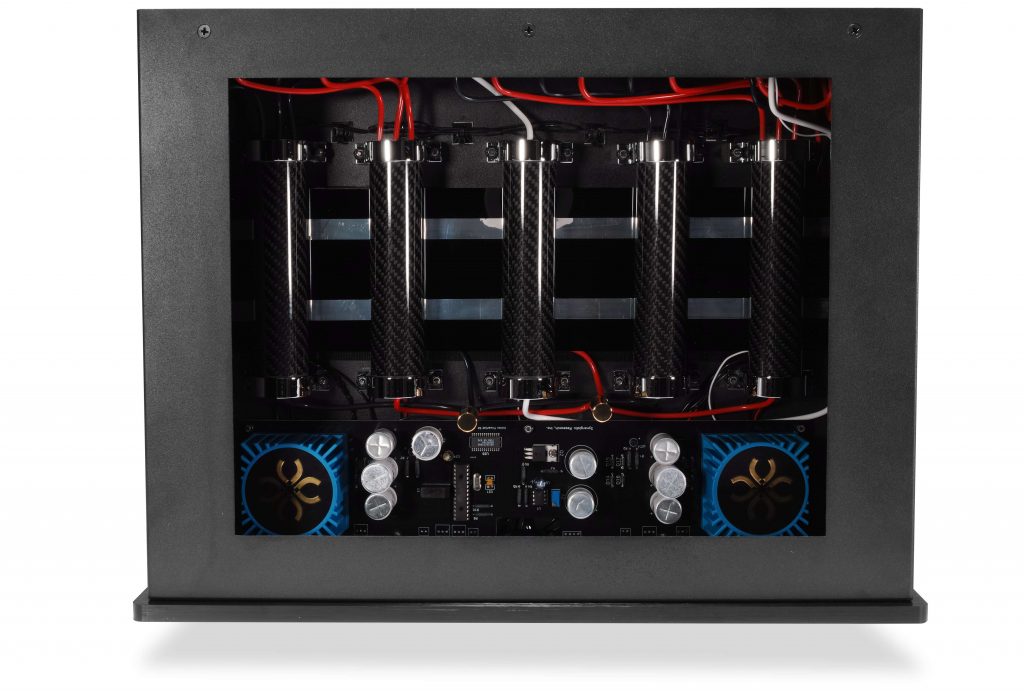
Cutting to the sonic chase, the improvement brought by substituting the SR PowerCell SX Power Conditioner was not subtle, and did not take significant amounts of time to sort out. The earlier PowerCell 12 UEF had been good, a step up from my earlier PS Audio P-10, but the PowerCell SX really knocked it out of the ballpark. No contest, really.
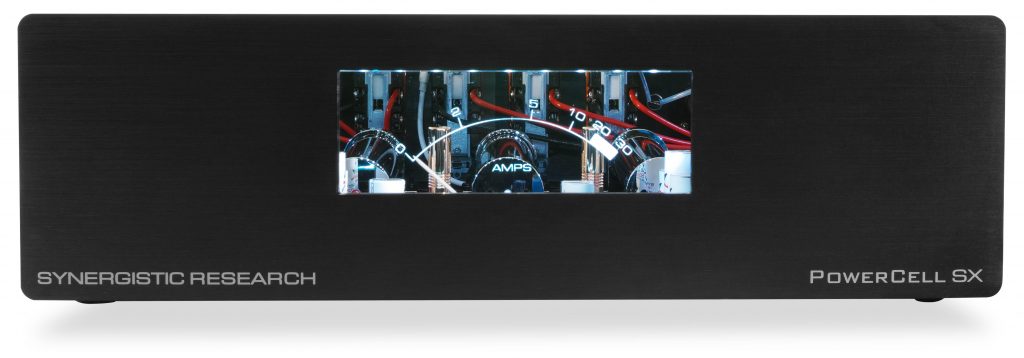
The noise floor dropped noticeably. The previous quiet of the PowerCell 12 UEF became "Oh my!" Transparency advanced, clearly indicating gains in the quality of the power. Our array of reference source devices will indicate imperfections mercilessly…as it should be, in my view…and they were shouting that the PowerCell SX was a system transformer. With improved transparency came greater detail, especially at the micro level. Dynamics improved; so did both imaging and soundstaging. These advances are not surprising. I've found that as transparency progresses, so do all other audio virtues, following in the wake of transparency.
Everything clearer. Much clearer.
That's the Synergistic Research PowerCell SX, in a nutshell.
Another of my Brutus Award winners for 2020, without a doubt.
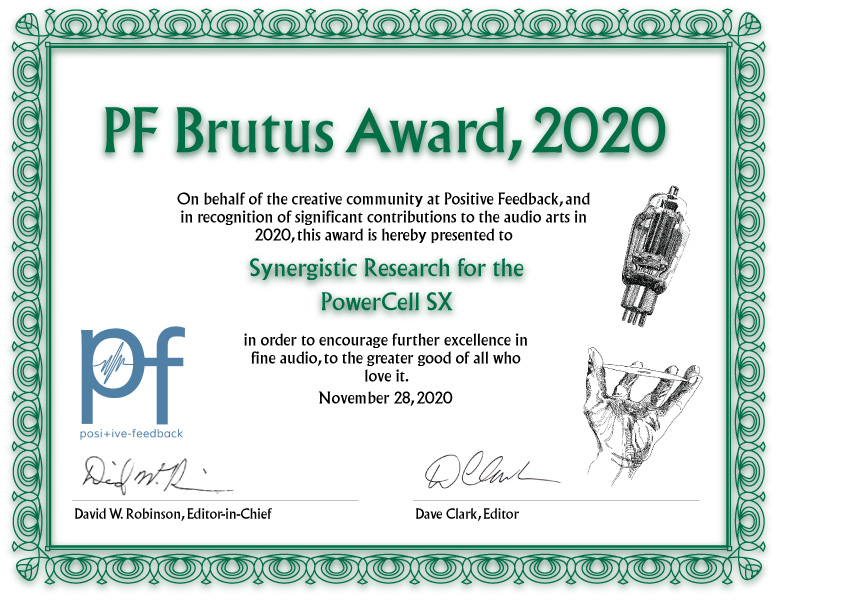
Synergistic Research MiG SX
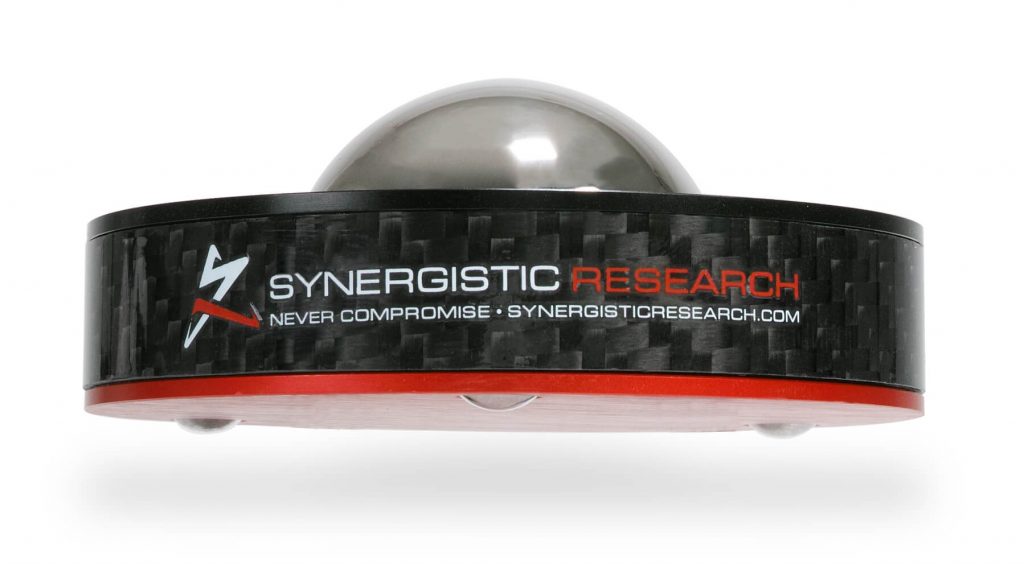
I've already commented on the SR MiG SX Isolation Devices back in Issue 112, in connection with my rave over the Warwick Acoustics Aperio Reference Headphone System. When I inserted a set of three of the MiG SX devices, the sound of the Aperio definitely improved. So much so, that I have left them there…I don't think I would want to use the Aperio without the SR MiG SX. (I'm saying that as I'm writing this section of my 2020 Brutus Awards, while listening to Sufjan Stevens via Qobuz to the Aperio, sitting on said MiG SX. It's really quite wonderful!)
As I said in Issue 112:
"Taking Ted Denney's earlier concepts to a higher level, the MiG SX devices did bring a greater clarity to the playback of the Aperio when I used them in this application. I had been listening to the Aperio for 300-400 hours when, on sudden impulse, I tried the set of three MiG SX with it.
I immediately noticed a subtle lowering of an already low noise floor. There was a slight, but definite gain in transparency, with improved sonic details. As a result, I am hearing what seems to be even better high frequencies…more air up there…and the Aperio is no slouch at all in any of these regards.
I've been listening to the Aperio with the MiG SX for many days now, and don't think that I would like to separate them. Nor should you. If you decide to purchase the Warwick Acoustics Aperio, you should also acquire a set of three SR MiG SX, as well, as a highly…er…synergistic match.
So, the MiG SX will remain with the Aperio system henceforth, with my blessing!"
Enough said.
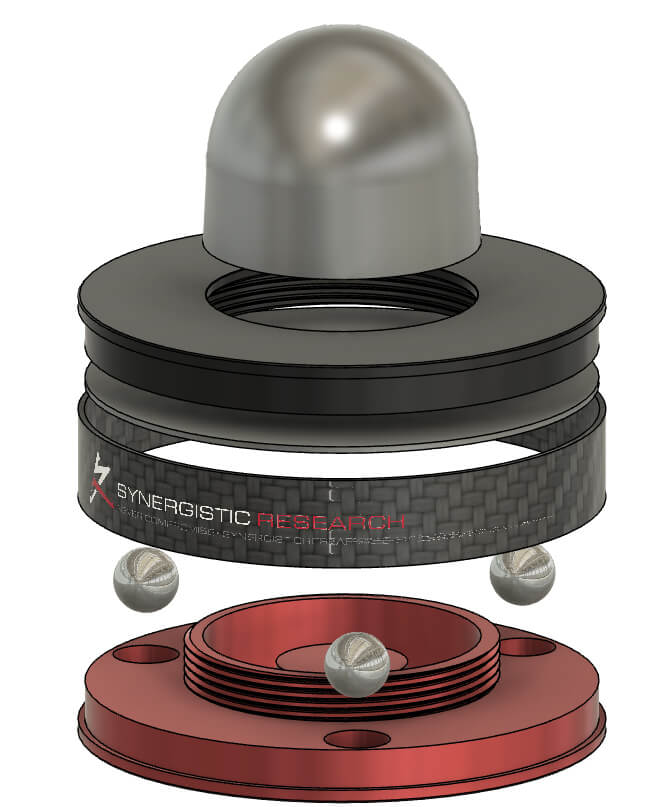
A Brutus Award for the SR MiG SX.
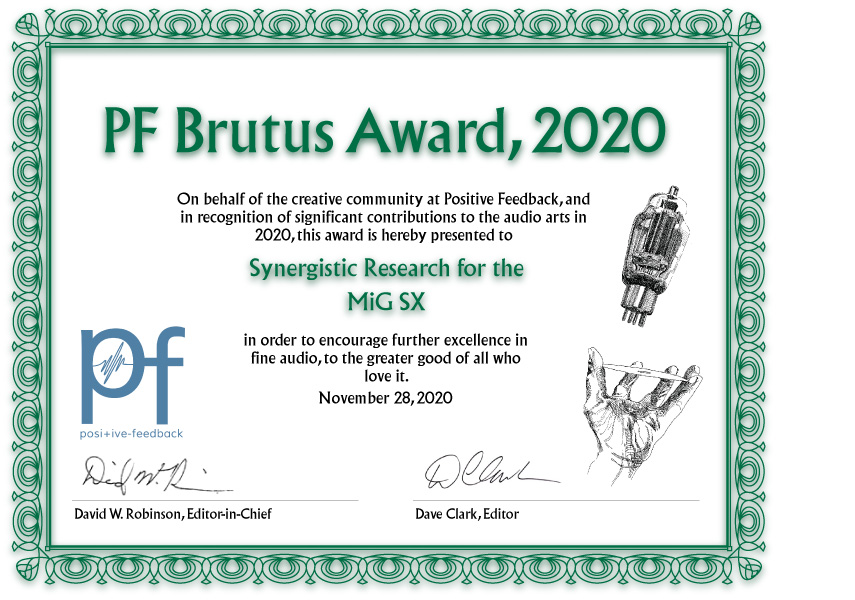
Synergistic Research UEF Record Weight
I have a goodly handful of record weights here at PF Central, accumulated over years of LP and turntable audiomania. Some are custom-built for a given turntables (the Wave Kinetics NVS, for example); most others are generic.
Earlier in 2020, Synergistic Research sent a review sample of a new and quite different LP weight: The UEF Record Weight. Carefully crafted of aluminum, with a carbon fiber body, internal suspension, and a placement pad for one of two HFTs that are used to tune the sonics of the UEF Record Weight.

SR says that the blue HFT is for greater spaciousness and detail, while you should use the red HFT on LPs in which you're seeking a warmer, smoother feel to the music. After doing my own listening comparisons, I can confirm these recommendations. They really do work in our system…and if they didn't, I'd know it.
Note that the UEF Record Weight is not a clamp. The SR Web site says that, after listening comparisons, they felt that going with a clamping version restricted soundstage development. Thus, after further testing, they opted to go with a free-standing "suspended" design. (See https://www.synergisticresearch.com/accessories/turntable/uef-record-weight.)
Our Wave Kinetics NVS Reference Turntable with the Durand Tosca Tonearm and the DS Audio DS Master1 Optical Cartridge and EQ/Phono Amp is a highly critical LP playback system. It is intensely revealing in ways that many other turntable systems cannot touch.
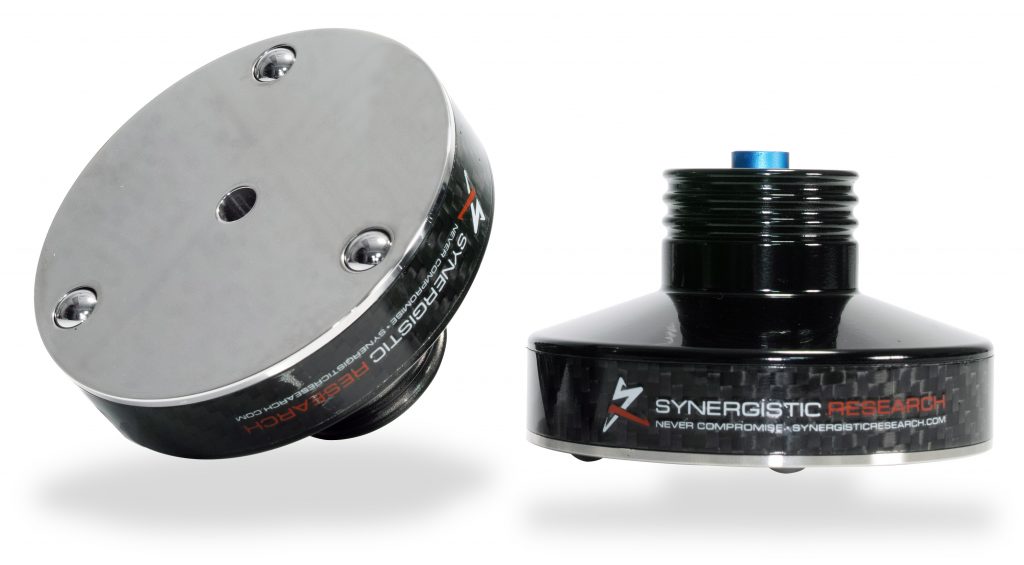
Placing the SR UEF Record Weight in place of several other weights that I've used there produced immediate and ameliorative effects. Since I can say that the Blue and Red HFTs do work in the manner that Synergistic Research indicates, you'll find (as I did) that you can fine tune your turntable to produce the right match for the album that you want to listen to. Personally, I use the blue HFT most of the time, but there are some LPs that are rather sharp-edged…for example, just about anything from the Mamas and the Papas, unfortunately…and will definitely benefit from the red HFT. You'll have to experiment to find the best combinations for your own preferences, of course.
The SR UEF Record Weight surprised me with the significant benefits that it brought to our reference turntable system. I am pretty sure that you'll find that it does the same for your LPs.
The retail price is $895, but you have SR's 30-day trial window to let you spin-before-you-buy, so there's really no risk to you for trying it. I think that when you do, you'll hear what I mean about the improvements that the UEF Record Weight brings.
This is a 2020 Brutus Award winner, for sure.
